

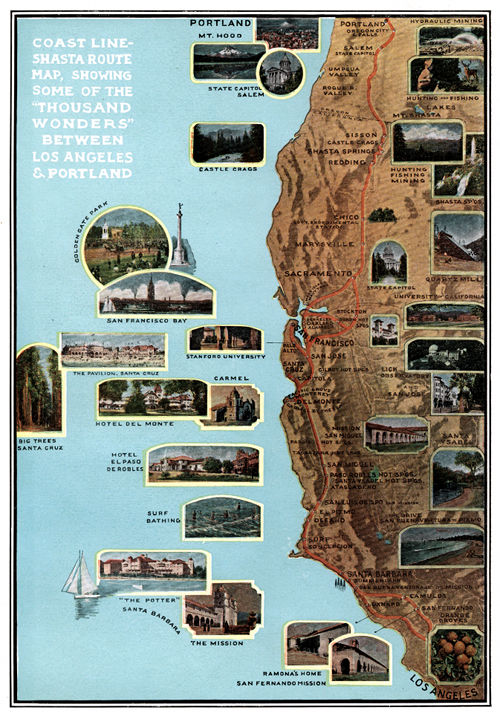
The Coast Line-Shasta Route of the Southern Pacific Company from Los Angeles Through San Francisco, to Portland, a Journey of Over One Thousand Three Hundred Miles
These Pages Picture and Tell of This Region and Its
Wonders, of the Varied Charms of Sea and Sky, of
Mountain and Valley, Field and Forest and of
Climatic Features Which Make Pleasant
All the Year; of Numberless Resorts
Attractive for Health-Seeking
Idling Enjoyment, and
All Out-of-Door
Recreation
PASSENGER DEPARTMENT
SOUTHERN PACIFIC COMPANY
SAN FRANCISCO, CALIFORNIA
1907
Sunset, the Magazine that Pictures the West and stimulates interest in all things beyond the Rockies, here points the way of tourist travelers to a most attractive and instructive feature in Far Western sight-seeing—the Wondrous Rail Highway Along the Pacific, joining California and Oregon, skirting spectacular Shasta, and over the sightly Siskiyous to the fast-flowing Columbia, through thousands of acres of roses and sweet peas, oranges and walnuts, wheat and hops, apples and apricots, with new things to see at every turn, and every comfort all the way. And don’t forget that you’ll find a continuation of this story, and will find other stories and pictures that will prove as interesting, in Sunset Magazine every month, in every year.
And now—
Shake hands! Kiss hands in haste to the sea
Where the sun comes in, and mount with me
The matchless steed of the strong New World
As he champs and chafes with a strength untold—
And away to the West, where the waves are curl’d,
As they kiss white palms to the capes of gold!
—Joaquin Miller.
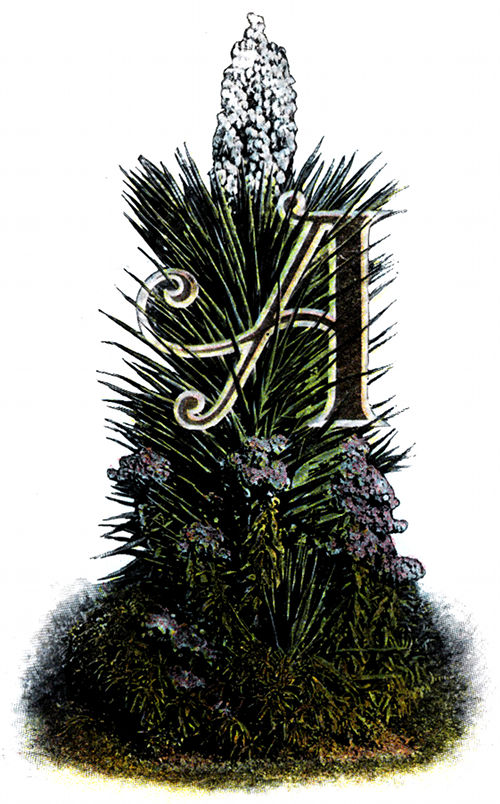
A thousand wonders? The man who gave that as a result of his count evidently dodged his task. If he’d counted all the things that set one wondering—things God-made and hand-made, things of sky and sea, of cañon and mountain, and field and forest—along this thirteen hundred miles of highway he would never have stopped at a mere thousand. Ten thousand would have been something like it, but modesty is a decent and not over-worked virtue, and ought to be cheered wherever seen. Let it go at a thousand and see if the glory of these wonders may be impressed upon you. The climate is first, of course. You cannot overlook the novel joy of a region where on New Year’s day, they battle with roses instead of snowballs. In the country around Los Angeles they do that sort of thing as a fixed festival, but the same floral ammunition, and the blue sky and soft air are the winter characteristics of a hundred other places along this road that joins Los Angeles to Portland, passing through San Francisco—this Coast Line and Shasta Route.
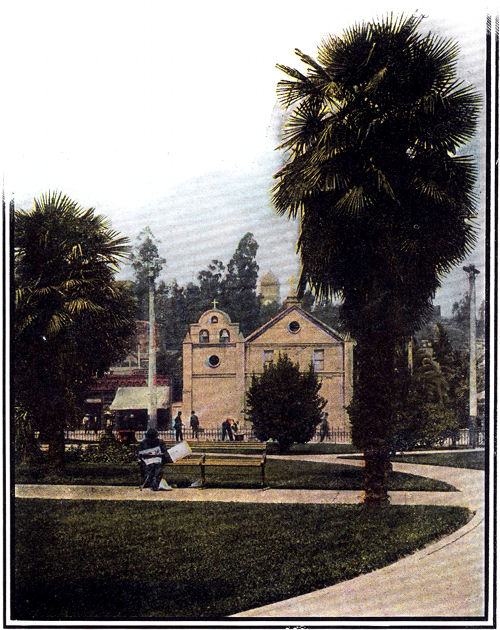
THE BUSTLING CITY OF LOS ANGELES CROWDS CLOSELY THE OLD MISSION CHURCH OF OUR LADY OF THE ANGELS
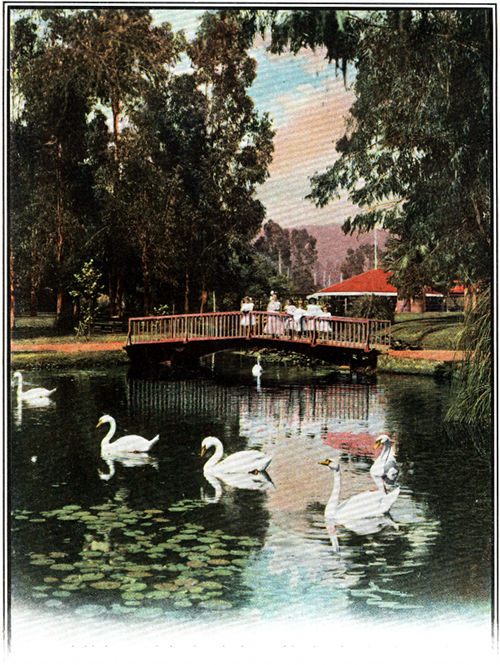
IN THE HEART OF LOS ANGELES WEST LAKE PARK IS AN ATTRACTIVE RESTING PLACE
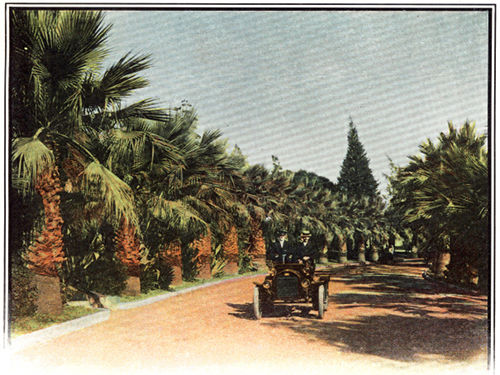
FAN PALMS AND SEMI-TROPIC TREES FRINGE THE WALKS BEFORE LOS ANGELES HOMES
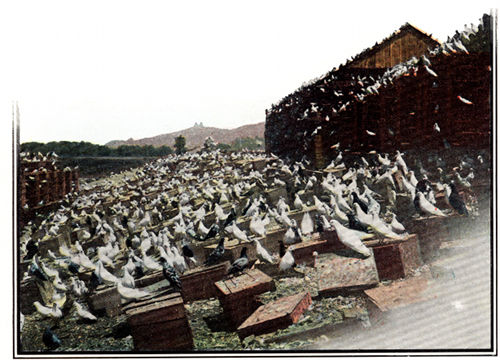
SQUABS BY THE MILLION, WAITING TO GO INTO PIE—A SIGHT NEAR LOS ANGELES
Away down in the southwest corner of this great nation of ours, behind mountain barriers, is the sun-kissed region that draws each year to it an army of tourists and seekers for that priceless joy that’s valued most when it’s lost health. It’s the great Land of Out-of-Doors here, with sunny skies and a climate that invigorates all the year around, all the way across the mesas and tablelands of the Painted desert region, across New Mexico and Arizona, across sandy wastes and cactus-spread plains into the Californian oasis country, where water and wisdom have helped make a paradise for all who believe that Nature is the best of doctors. It’s a sunshine orgy all the way. And Los Angeles, with its palms and olives, its crumbling adobes, side by side with thirteen-story fire-proof steel business blocks, electric railway cars whizzing everywhere—what a marvel of the Past, jostled by Progress! Here are hotels of all sorts and sizes, and homes that are marvels of luxury and elegance. Here you can study climatology and sociology, with variations; can view the simple life through the eyes of the man whose only home is a covered wagon; or, you can get a permit to enter the iron gateway of the park of some retired millionaire. Los Angeles, however, with all its charms, is only one small corner of Out-of-Door Land. The holy fathers of Mexico and old Spain found that out over a hundred years ago, when they started from Loreto, in Paja California, to make their mission pilgrimage up the Alta California coast. From San Diego and Los Angeles they headed northerly, establishing their mission stations a day’s journey apart. In sheltered valleys, on slopes that look far to seaward, by never-failing water courses, they planted the cross and marked out the boundaries of their holdings. No wide roadways could be thought of, but connecting these stations there soon was marked a broad trail—El Camino Real—the Highway of the King. Perhaps—who knows?—this name was given to do double honor—to the King of Kings, whose cross the padres bore, and to that monarch of Castile, whose bidding they were doing in aiding to carry his dominion into the newer world. Up the coast this old-time highway ran and to-day the steel highway of The Road of a Thousand Wonders follows it closely at many points, joining the missions of Los Angeles, San Gabriel, San Fernando, San Buenaventura, Santa Barbara, La Purisima, Santa Ynez, San Luis Obispo, San Miguel, San Antonio, Soledad, Carmel, San Juan, Santa Cruz, and others, just as musically named. The railway touches or runs close to all of these. At all these spots these wise men of the long ago found attractive sites, all under health-giving sun, and bathed by pure air, with a benign climate the year around. At Sonoma, a little north of San Francisco, the King’s Highway ended, but adventurous spirits pushed on northerly, up the headwaters of the Sacramento, and over the mountains into the Oregon wilderness, meeting before then trails of trappers and couriers du bois of the old Hudson’s Bay Company. And, over this trail of the trappers, runs the steel highway of to-day, bearing the traveler in comfort amid historic scenes. All of which—that well-worn Highway of the King, the missions, the trail of the trappers—sounds like romance with a liberal blend of realism. These twain are characteristic of all the big West—webs of romance and realism, lines of sentiment and science crossing and recrossing. It’s a garden land for poet or novelist.
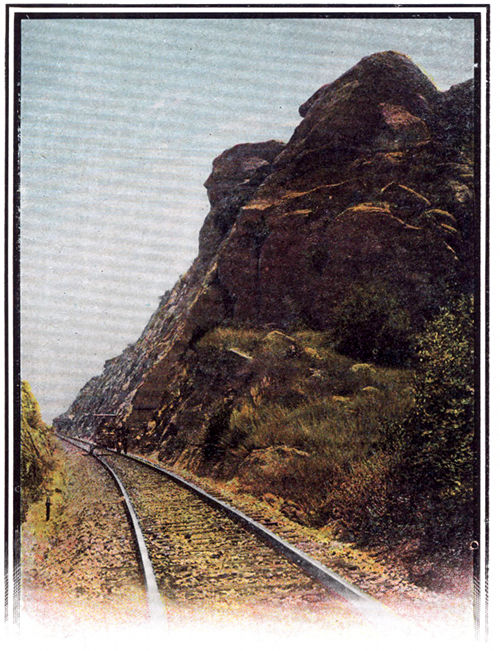
THE SPHINX ROCKS IN CHATSWORTH PARK CAÑON WHICH HOLDS MANY CURIOUS ROCK FORMATIONS
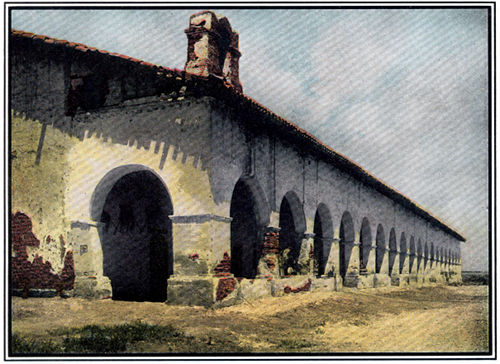
A CORNER OF MISSION SAN FERNANDO REY
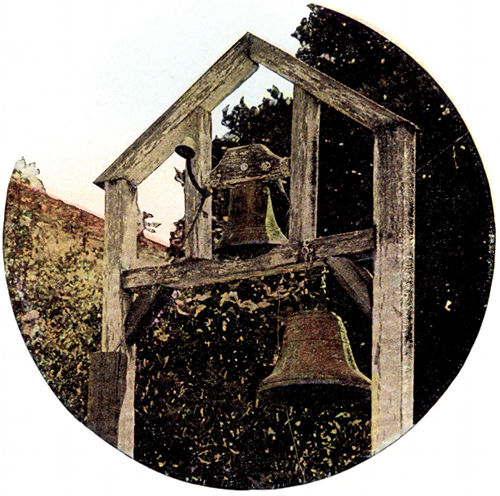
BELLS OF THE GARDEN AT CAMULOS
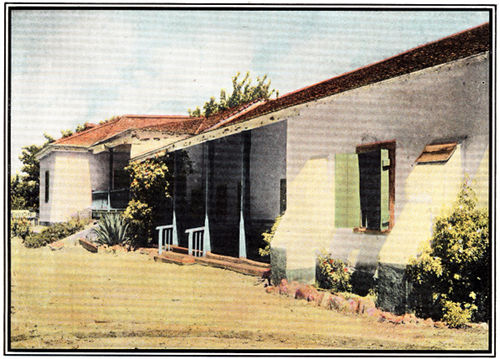
CAMULOS, THE HOME OF “RAMONA” HEROINE OF HELEN HUNT JACKSON’S FAMOUS NOVEL
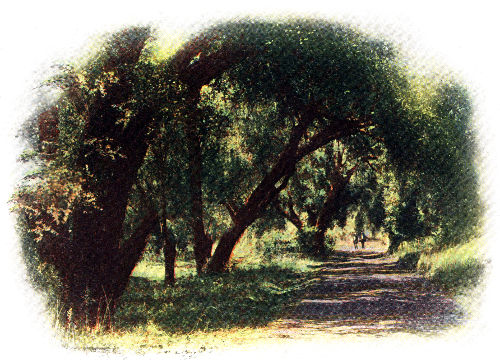
STURDY, SHADY, OAKS, SWIFT FLOWING STREAMS AMID A WEALTH OF GREENERY, MAKE A TINY EDEN OF THE BEAUTIFUL VALLEY OF OJA
Thus Joaquin Miller, poet and philosopher of California, sings:
Behold this sea, that sapphire sky!
Where nature does so much for man,
Shall man not set his standard high?
And plots for novels like Helen Hunt Jackson’s “Ramona,” are lived not at all infrequently. The old Del Valle ranch—Camulos—where the author of “Ramona” stayed for a while—is yearly becoming a more popular pilgrimage. It’s a quaint, low-porched, thick-walled adobe ranch-house, close by the train—a type in its way of the California life that is past.
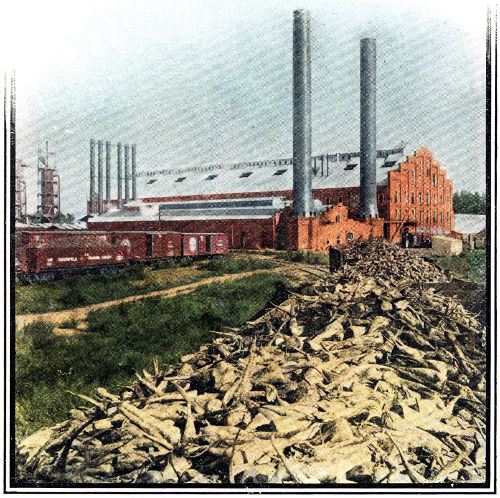
SUGAR FROM THE SOIL—THE BEET SUGAR FACTORY AT OXNARD.
Some years ago the books of Charles Nordhoff, correspondent and journalistic freelance, were widely read, largely because he had the gift of seeing and of making others see through his words 11 with his eyes. His letters to eastern publications were filled with his vivid pictures of this southland country. In the snug Ojai valley, close by the Coast Line, where now a town bears his name, he came and made his home for many years. Here, beautifully framed by rugged mountains, is one of Nature’s sanitariums where crowds of health seekers come annually to enjoy the dry air, cooled to reasonable comfort by the nearness to the sea. Not far away, traveling by the direct Coast Line from Los Angeles, is Oxnard, site of a beet-sugar factory that sweetly influences the freight shipments with its large annual output of the finest sugar. Something like 23,000 tons or 46,000,000 pounds of sugar are turned out here annually. In the regular season over 2,000 tons of beets are handled daily.
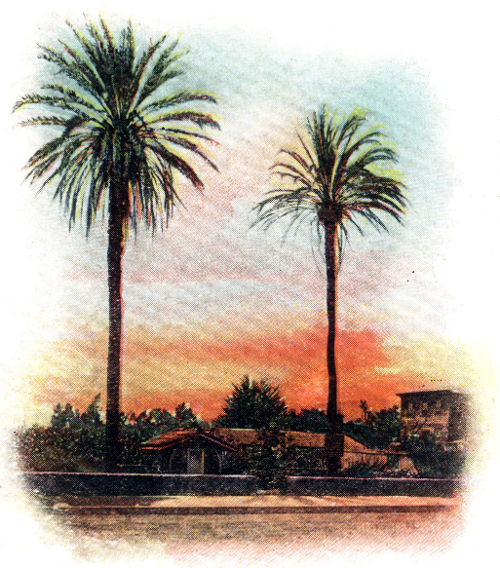
ANCIENT DATE PALMS AT VENTURA, AND THE PROTECTING LODGE BUILT BY DAUGHTERS OF THE GOLDEN WEST
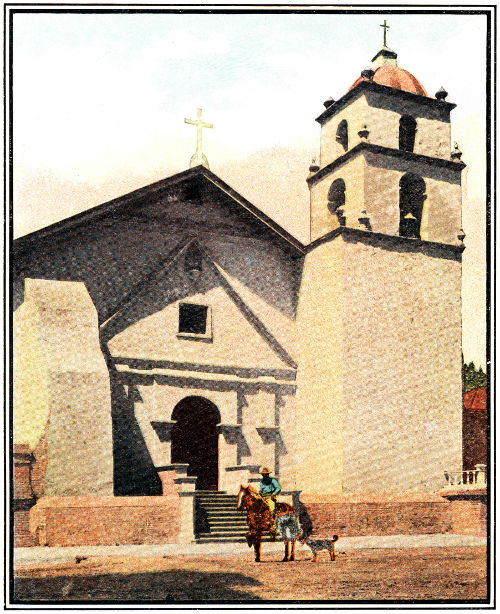
THE MISSION SAN BUENAVENTURA ESTABLISHED 1782
Walnuts, olives, oranges, beet-sugar and beans are the notable features of orchard and field in the region about San Buenaventura. The old mission, in excellent preservation, established in 1782, is still used as the parish church for that region. All the way from here to Santa Barbara and beyond, the traveler is continuously under the spell of the sea, for the track skirts the coast upon the bluff high above the booming surf, by ever-changing pictures of 12 clouds and sea and sky, with an occasional steamer or sailing craft to give them life. Along here is Carpinteria, an old Spanish settlement, which possesses among its features of interest, an ancient trellised grape vine, nearly three feet in diameter at its base. At Summerland there is a veritable forest of oil derricks stretching along the beach, many of them in the surf and even at sea far beyond the low tide mark.
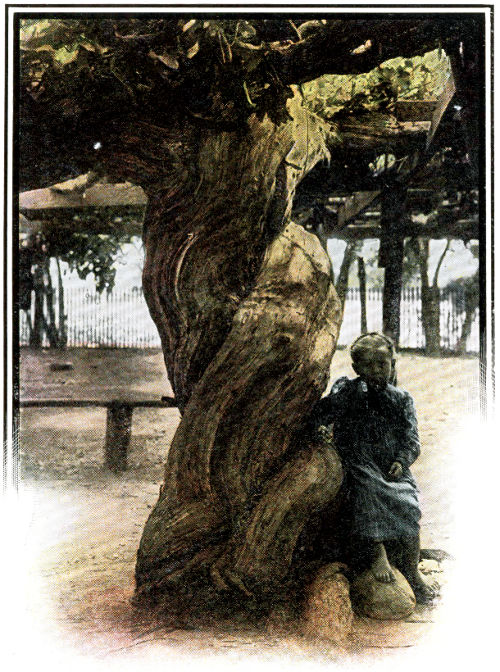
THIS IS THE LARGEST GRAPEVINE IN THE WORLD—SIXTY YEARS OLD—TEN TONS OF GRAPES IS ITS RECORD CROP
A vivid contrast to Summerland’s forest of derricks is Miramar, by the sea, as its name suggests. It is a colony of summer and winter homes, with climbing roses, and palms and tropical foliage waving in the gardens all about. Miramar is a suburb of Santa Barbara, as is Montecito, another charming foothill site for country homes.
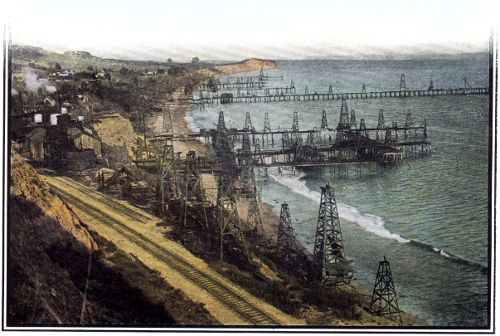
WHERE OIL AND WATER ALMOST MIX—DERRICKS AT SUMMERLAND WHERE OIL IS PUMPED FROM BENEATH THE OCEAN
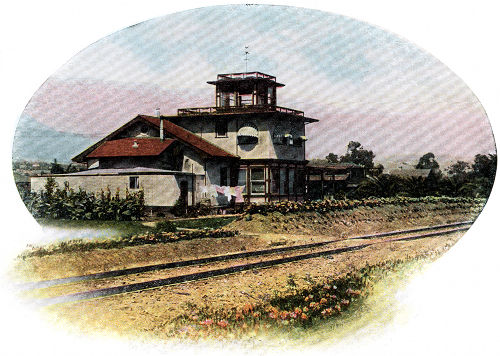
AT MIRAMAR THE TRAIN SPEEDS BETWEEN BANKS OF BRILLIANT AND SWEET SCENTED BLOOM
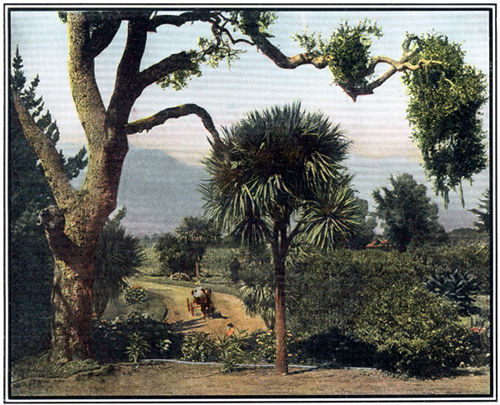
THE VALE OF MONTECITO, FAIREST OF FOOTHILL FANCIES HAS A SEMI-TROPIC CHARACTER WITH ITS ORANGE, OLIVE AND LEMON GROVES, ITS FLOURISHING PALMS AND FLOWER-SET RESIDENCES
And then Santa Barbara, peerless among all-the-year-round resorts. It is backed by mountains that rise high above the city and shelter it from every wind, facing a channel and bay of remarkable beauty and calmness, with a temperature of wonderful equability, with groves of oranges and olives and lemons, with the tropic foliage of date-palms and bananas, magnolia, oleander and other graceful trees and shrubs, with unrivaled gardens of perpetual bloom and fragrance: easy of access, unexcelled for its schools and libraries, with social advantages among people of culture and cheerful living. The place has ever been a favorite winter resort for health tourists, and in summer Californians have long frequented this beautiful coast city, with its remarkable stretch of bathing beach and its charming walks and mountain drives, its opportunities for athletics and all out-of-door sports.
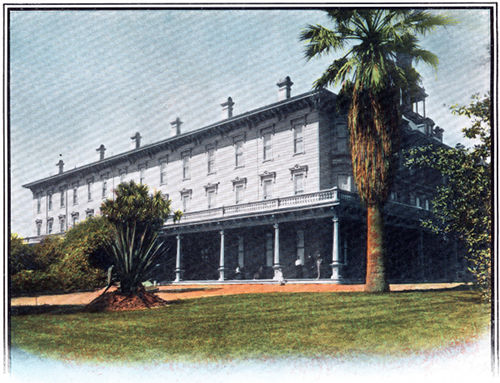
AT SANTA BARBARA THE ARLINGTON IS A FAVORITE RESTING PLACE BOTH WINTER AND SUMMER
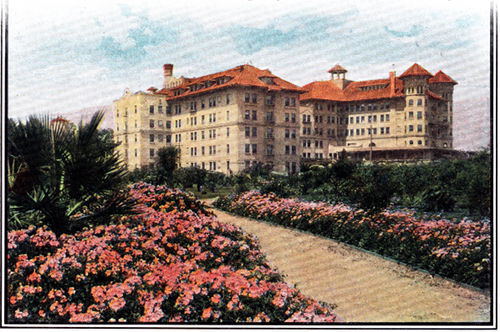
DOWN BY THE SEA AT SANTA BARBARA THE POTTER GREETS AN ARMY OF GUESTS ALL THE YEAR
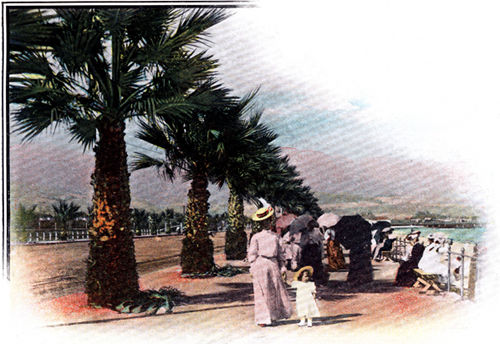
AN OCEAN BOULEVARD, DRIVEWAY AND PROMENADE COMBINED, EXTENDS FOR MILES ALONG SANTA BARBARA’S ATTRACTIVE BEACH
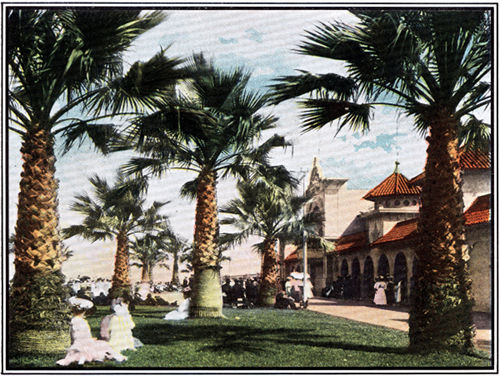
THE BOULEVARD LEADS TO A BATH-HOUSE OF UNIQUE DESIGN—LOS BANOS—CLOSE BY THE SEA
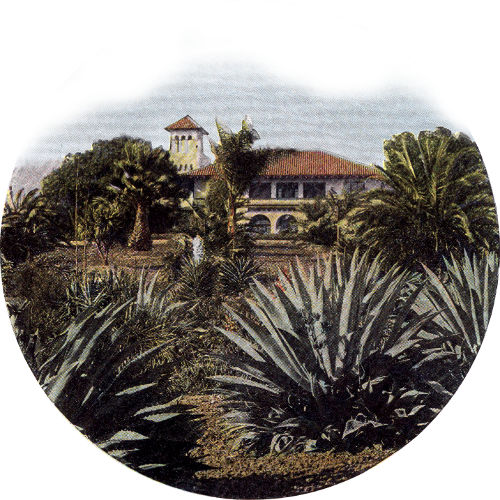
SANTA BARBARA RESIDENCES ARE DESIGNED TO CONFORM TO THE SEMI-TROPIC SETTING OF TREES AND FLOWERS
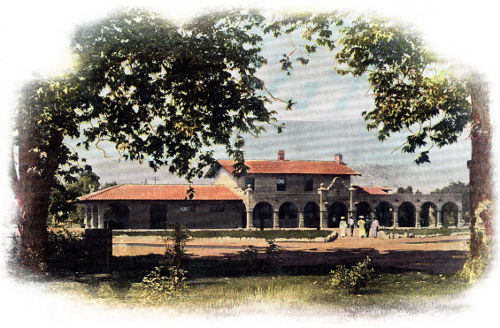
THE SOUTHERN PACIFIC RAILROAD STATION AT SANTA BARBARA IS SUITABLY BUILT IN MISSION STYLE
The hotels are first-class in their equipment, the principal ones being the Arlington and the Potter. The new railway station of the Southern Pacific has been built close by the Potter, and the city grows close about it. The hotel grounds are elaborately laid out, running down to the long boulevard that fringes the stretch of perfect ocean beach. Close by is a well-equipped bath-house, with the ocean itself as an annex for more ambitious swimmers. The population of Santa Barbara and suburbs is made up very largely of people world and climate-weary, driven by stress of storm or cold from more rigorous climes. Here, upon these foothills, surrounded by Nature’s lavish bounty, they have built their homes, prepared to face their future in climatic comfort. The city’s chief attraction is Mission Santa Barbara. The church is of dressed stone and adobe, with massive walls heavily buttressed. The towers yet shelter the chime of bells, and the famous garden with its fountain, so often pictured, still fills the air with fragrance. Buildings have been carefully preserved, and form to-day the most interesting and imposing of all the California missions. The average annual winter temperature here is fifty-four degrees; the summer, sixty-five. Seldom does the temperature rise above eighty degrees or go below forty, but there’s a tonic of new life in the air, even though it has no month so cold as April at Atlantic City, nor any month so warm as New York’s June. Here Stewart Edward White, the man who wrote “The Mountains,” that stirring epic of Out-of-Doors, has his year-around home. To seaward from Santa Barbara can be seen the Channel islands, wondrous isles for fishermen and tourists. The marvelous caves running in from the sea, the seal, the Indian relics, the plants and trees, are all of strange interest. The run up the coast from Santa Barbara to Surf, and nearly all the way to San Luis Obispo, is, to him who loves the sea, a never-ending source of delight.
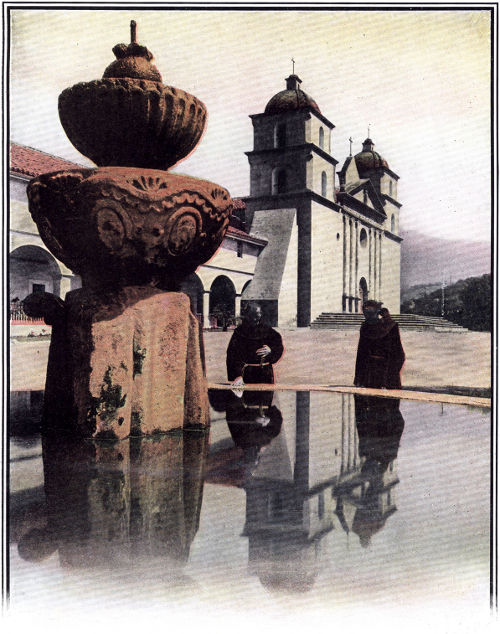
AT MISSION SANTA BARBARA (ESTABLISHED 1782) THE BEST PRESERVED OF THE CALIFORNIA MISSIONS
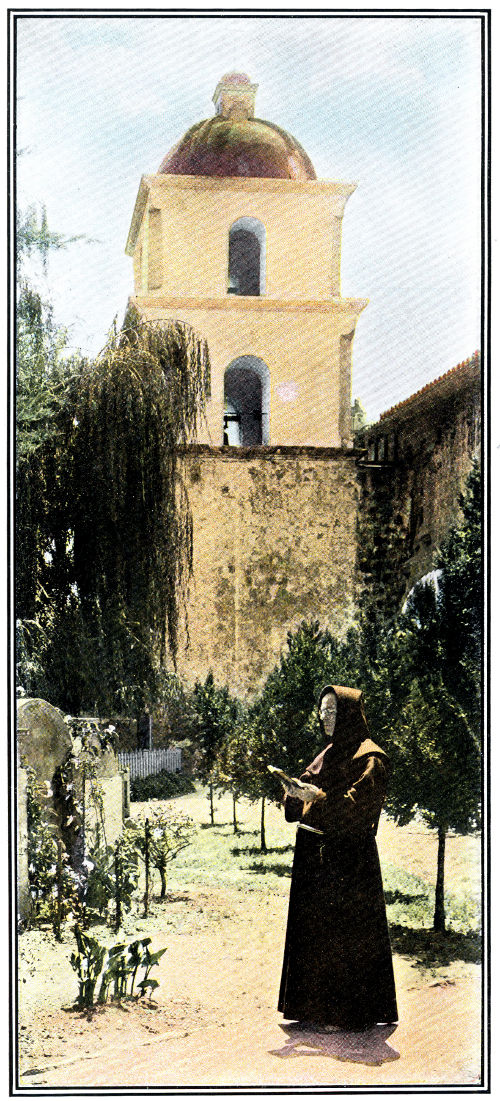
THE BELFRY OF MISSION SANTA BARBARA—THE BELLS HERE WERE SENT FROM SPAIN A CENTURY AGO
At Elwood, one passes the pioneer olive farm of Mr. Ellwood Cooper, who came here from Boston over a quarter century ago, when olive oil, oil pickles and kindred industries were almost unknown in this country as commercial enterprises.
All this region, the rolling hills to the east and the high plateau that runs far out on the Point Concepcion peninsula, once formed the domain of the native Californians, many of them grandees of old Spain. Like lords of the Middle Ages these land-holders held large possessions under grant from the king, ranging their stock over vast ranches of from fifty thousand to one hundred 19 thousand acres. Of such was El Cojo rancho around Point Concepcion; the Santa Margarita, El Sur, Piedra Blanca, and a hundred others. These ranches are being cut up very rapidly to satisfy the demands of increasing population and of appreciative home-seekers. To these old families California to-day is indebted for many musical names—Arguello, Castro, Estudillo, Pacheco, Vallejo, Peralta, Alvarado, and many others are here, the lingering of early-day nomenclature amid the present made-over maps.
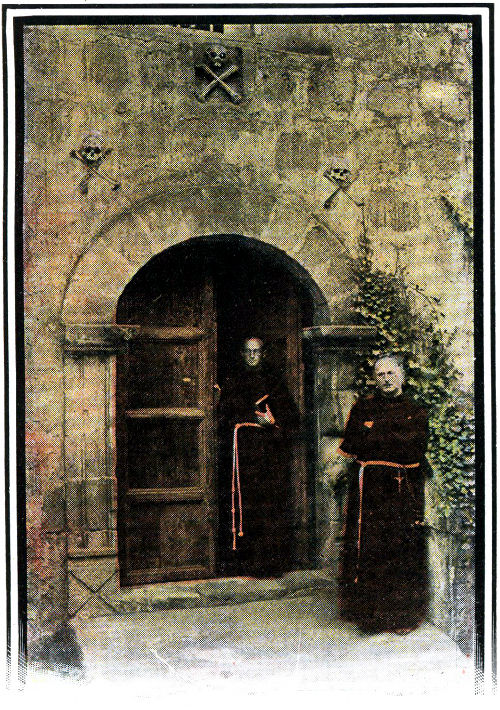
THE CHAPEL DOOR AT SANTA BARBARA
Beyond Point Concepcion, to the east are two of California’s most fertile valleys, the Lompoc and the Santa Ynez, fruitful, progressive, ideal locations for the farmer and fruit-raiser. Here, too, are located, two of the most interesting of California’s missions, La Purisima Concepcion and Santa Ynez. La Purisima mission is reached from Lompoc by way of Surf, and Santa Ynez from Los Olivos, by way of San Luis Obispo, or from Gaviota, by a picturesque highway, leading over the mountains, through the Gaviota pass, and close by the wildly beautiful cañon and falls of Najoqui.
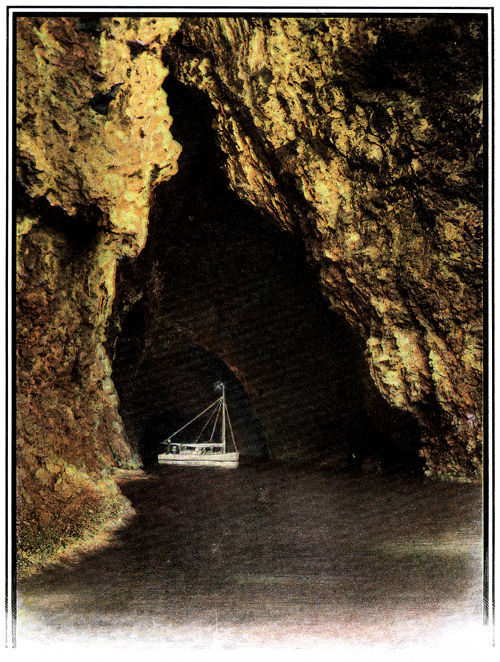
THE PAINTED CAVE ON SANTA CRUZ ISLAND RIVALS THE BLUE GROTTO OF CAPRI IN ITS COLORING OF ROCK AND WAVE-DEEP IN ITS VAULTED CHAMBERS SEALS AND SEA LIONS MAKE THEIR HOME
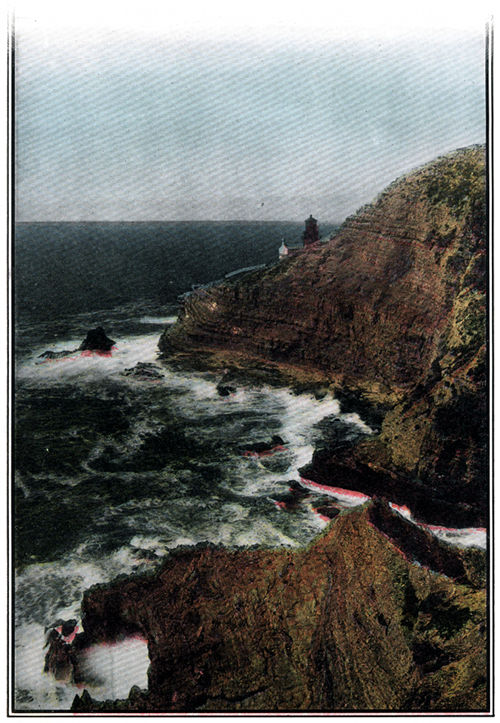
THE LIGHTHOUSE AT POINT CONCEPCION IS ON THE SHELF OF A SURF-BEATEN CLIFF THAT RISES TWO HUNDRED AND FIFTY FEET ABOVE THE SEA
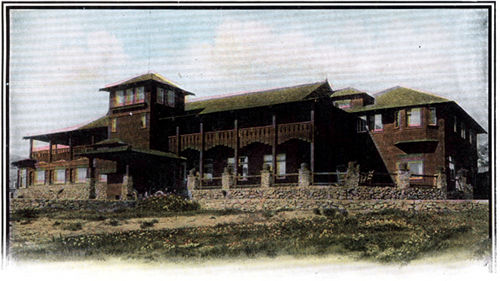
AT EL PIZMO BEACH IS A NEW HOTEL WITH ATTRACTIVE COTTAGES AND TENTS
Down San Buenaventura way the traveler has seen beans in thousand-acre tracts, beans by the million, shipped in sacks to help out the world’s food supply. Along here, at Occano and Arroyo Grande, enterprising seedsmen are growing peas, peas by the million, but they are sweet peas, whose value is in the blossom and not in the pod. It is a sight worth crossing many continents to look upon—a sweet-pea farm in full bloom. A resort near Oceano is El Pizmo beach, over twenty miles long and several hundred yards wide—as pretty a piece of sand stretch as uncle Neptune ever bade his ocean minions to build. The pounding waves of countless centuries have here rolled the white sand upon a firm, gentle slope forming a bathing beach large enough to wash half the world upon, while forming an automobile speedway that can hardly be surpassed and that is largely patronized. And a good part of the world is learning about El Pizmo, surely and enthusiastically. An elaborate resort hotel has been built here; attractive cottages have gone up on the sand dunes here about, and a tent city has been built. Near here, too, is La Grande beach, a wonderful sight to see.
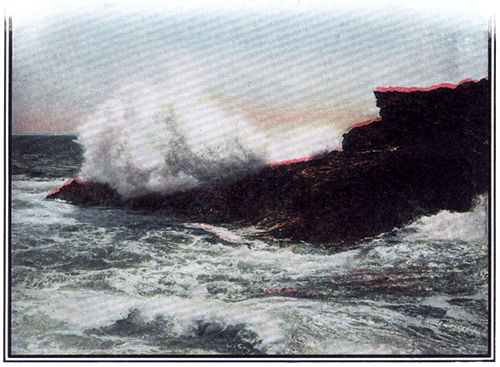
THE COAST NORTH OF SANTA BARBARA IS RUGGED AND WILD. WITH THE SURF POUNDING RESTLESSLY UPON JAGGED ROCKS AND HEADLANDS
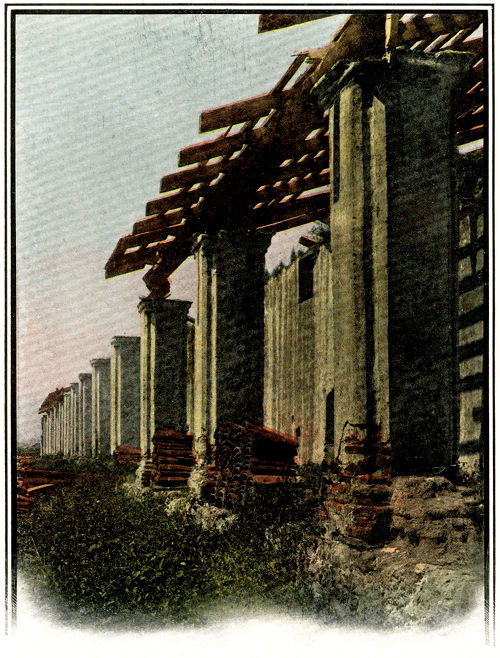
MISSION LA PURISMA CONCEPCION. IN THE BEAUTIFUL VALLEY OF LOMPOC—THE OLD RAFTERS, WITH THEIR RAWHIDE LASHINGS, STILL REMAIN AND KINDLY HANDS ARE PRESERVING AND RESTORING THE BUILDING
From far away the traveler approaching San Luis Obispo—the city whose mission was named by the Franciscans to honor the memory of their beloved bishop of Tolosa—sees a series of mountains that make him wonder if he is in the land of the Ptolemys. There are few more interesting or stranger formations than these pyramids that form the setting of San Luis Obispo; one that is peculiarly cleft, suggests a bishop’s miter, and this quaint freak of nature is said to have inspired the Padre Lasuen to give the city its name. The well laid out city is finely built, with many shade trees, well made roads, excellent water system, electric light and gas. In location it resembles Los Angeles, though it is nearer the ocean. The summer temperature has a maximum of ninety-four degrees; the winter minimum is thirty-two degrees. Lemon and orange trees thrive and roses bloom the year around. The many drives include a twelve-mile ride to El Pizmo, already described, a seven-mile trip to the famous San Luis Hot Springs with its sulphur plunge and baths located amid a beautiful sycamore grove, a nine-mile journey to Avila beach, near Port Harford, a fourteen-mile excursion to the famous Morro, with its singular rock towering above the ocean, and a seven-mile ride up Reservoir Cañon. In the heart of the town is the old mission, founded in 1772.
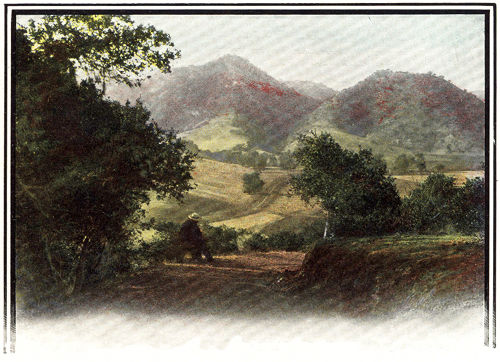
ON THE GRADE TO SAN LUIS OBISPO HOT SPRINGS
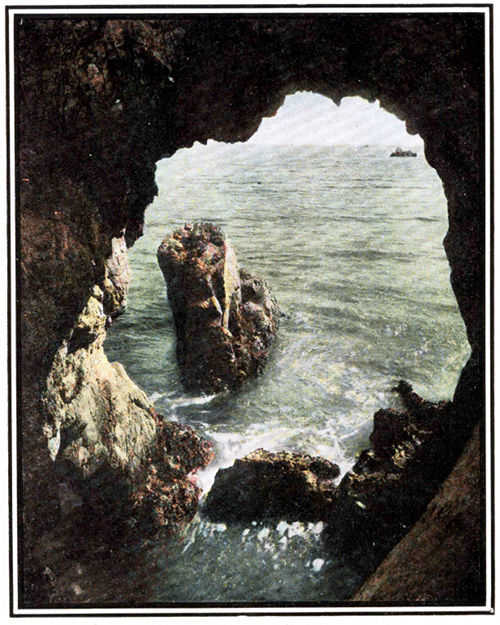
FISHERMAN’S COVE NEAR SAN LUIS OBISPO—A FAMOUS RESORT FOR ANGLERS, AMATEUR AND PROFESSIONAL
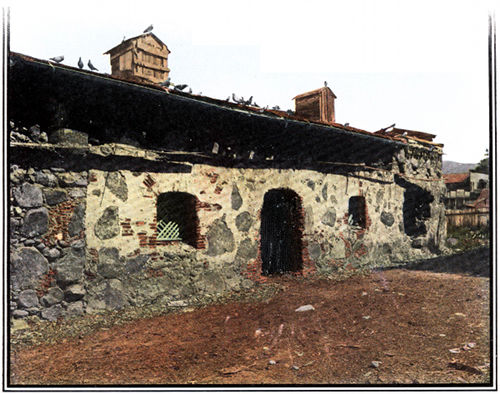
A SECTION OF MISSION SAN LUIS OBISPO TO-DAY, SHOWING THE SUBSTANTIAL CONSTRUCTION
From San Luis Obispo northerly, the railway climbs the Santa Lucia mountains, spurs of the Coast Range, noted for the beauty of their cañons, their oak-clad hillsides, their trout streams, their wild flowers in springtime, with marvelous bits of highland scenery at every curve of the road. The train comes close to playing crack-the-whip at several points over the Santa Lucia grade, and one may see at frequent intervals, far below, the track which the train has just 24 covered. Down the upper or northern slope of the Santa Lucias the train enters the Salinas valley, producer of wheat, of fruit, of stock—one of the oldest settled and best known of the paradise valleys of the state. It is narrow here at this upper end, with heavily wooded slopes and hundreds of streams that come tumbling down to the Salinas river which flows in a northerly direction to the beautiful bay of Monterey.
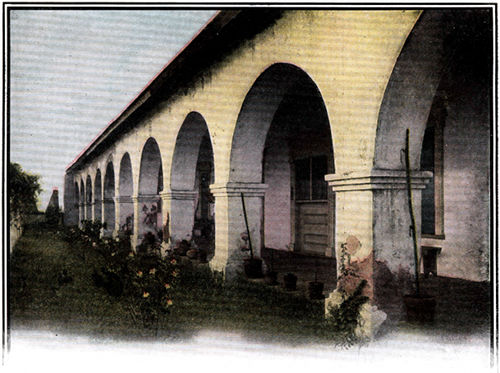
THE MISSION OF SANTA YNEZ, NEAR LOS OLIVOS, STILL PRESERVES MUCH OF ITS OLD-TIME OUTLINE
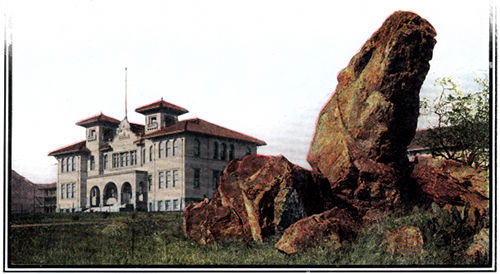
CALIFORNIA POLYTECHNIC SCHOOL NEAR SAN LUIS OBISPO, WHERE DIPLOMAS IN USEFULNESS ARE AWARDED
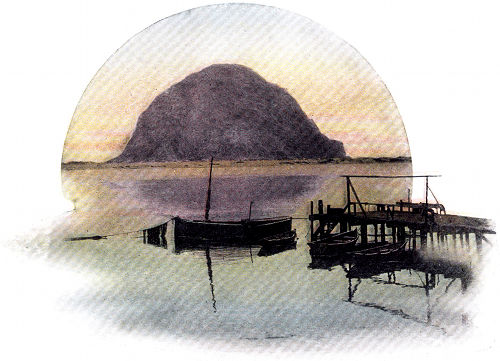
LONELY MORRO ROCK, THE HAUNT OF SEAL AND SEA FOWL.
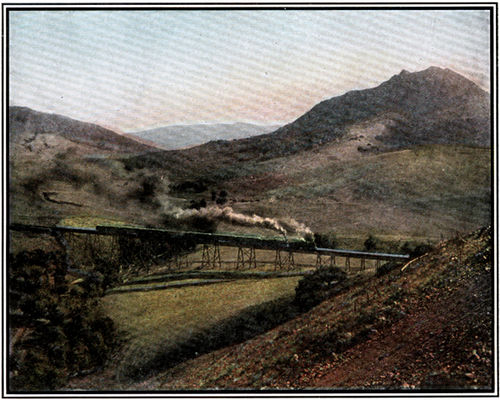
NEARING HORSESHOE CURVE—AFTER LEAVING SAN LUIS OBISPO THE TRAIN CLIMBS THE SANTA LUCIA RANGE—MARVELOUS SCENES AT EVERY TURN
At Atascadero one may see the maneuvering ground of a recent encampment of national guard and regular army soldiers. If men who go to war could have their choice of an ideal camping and fighting country they would surely select a spot like this, with plenty of shade, plenty of water, rolling hills for defense, and ambuscades of chaparral and manzanita on the hillsides for shelter. This site is one of several recommended for one of five permanent army camps, where volunteers and regulars may be drilled side by side. Another is the great Nacimiento ranch that lies beyond the Mission San Miguel.
Beyond this point the valley broadens and the road enters the hot spring region, in the center of which is El Paso de Robles, the “pass of the oaks.” Here at Paso Robles and at Santa Ysabel, close at hand, are mineral springs of all sorts and temperature, clay-mud, sand, iron, sulphur, soda, lithia; all within a small area as if marshaled for the healing of the nations. The elevation is 720 feet above sea level, about that of Carlsbad, Baden-Baden, or Kissingen. A flowing well furnishes 2,000,000 gallons daily of hot sulphur water, excellent for both internal and external uses. The hot lithia spring is 124 degrees; the great sulphur spring 107 degrees. The sanitary value of these wonderful founts of healing was recognized long ago, and every season seekers for health come to be cured, as the sufferers of France make pilgrimage to Lourdes; the dry air, the sunshine, the healing waters from Nature’s laboratory soon make the patient feel as good as new.
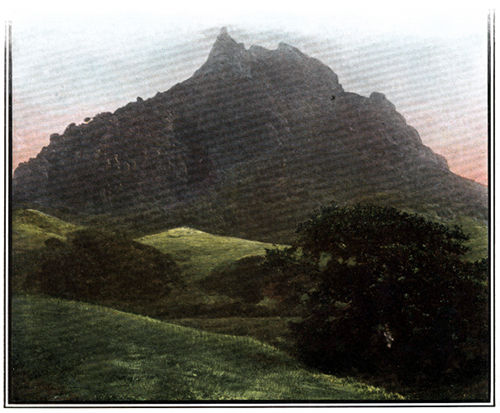
MITER MOUNT—ONE OF THE MANY WONDERS OF THE SANTA LUCIA MOUNTAINS WITH THEIR OAK-CLAD HILLSIDES AND INVITING CAÑONS WHERE EVERY CURVE SUGGESTS AN IDEAL HOMESITE FOR YOUR CASTLE IN SPAIN
The hotel here fulfils a joint mission, entertaining recreation-seekers as well as those looking for the boon of health. It is a modern, elaborately equipped hotel, with every twentieth-century convenience, and an annex that expresses the last word, architecturally and scientifically, in the line of a bath house. It is completely fitted for the use of all modern water cures. It cost over $100,000. Into it has gone the thought and suggestion of the best authorities in hydrotherapy. The baths are fitted with a splendor that suggests the bathing luxuries of ancient Rome—pure white marble 27 from Carrara, glazed white tiles, “novus” glass for the mud baths, porcelain tubs, spotless woodwork. All the patients are scientifically treated by a competent physician, expert in the methods of securing the most effective results from water treatment. The latest apparatus has been secured, and nothing in the scientific application of water, hot-air, hot-mud, vapor, or electricity, is wanting. Paso Robles is the center for many interesting drives, and time runs rapidly driving, riding or automobiling about the hills, to the seacoast, or to Mission San Miguel. Any of these drives among the hills, under the oaks out in the sunshine, will produce results that any doctor would be proud to send a bill for.
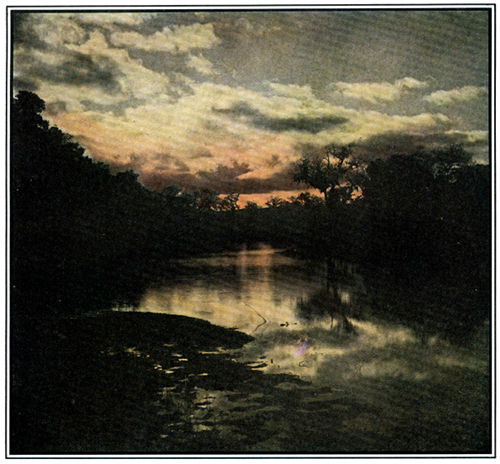
SUNSET AMONG THE OAKS AND SYCAMORES THAT BORDER LAKE YSABEL
Beyond San Miguel and its mission, quaint and interesting, is Bradley, where there are large coal deposits, and oil experts look wise when they rove in this region. Westward from San Lucas and King City is the Jolon valley and the San Antonio country, in the heart of which is the Mission San Antonio de Padua, established 1771, one of the most ambitious in architecture of these citadels of faith. It has crumbled sadly from lack of care, but the restoring hands of the Landmarks Club are planning to put the old pile in the best order possible for preservation. More hot 28 springs are close by; the Paraiso, reached by stage from Soledad, near where is Mission de Maria Santisima de la Soledad, established 1791. Two hours’ drive away is one of the wonders of the trip, Vancouver’s Pinnacles, now a government forest reserve. Here are vast piles of rock, that form an interesting study to the geologist and naturalist. Vancouver, exploring this region long ago, is credited with the discovery of this strange grove of granite and basalt monuments. Going on, the Spreckels beet-sugar refinery, the largest in the world, is seen to the west, just south of Salinas. Every season more than 200,000 tons of beets go into the capacious mouths of this modern monster that works a chemical miracle—turning raw root product into finest sugar. The output last season (1906) was close to 30,000 tons of sugar. The factory’s daily capacity is 3,000 tons of beets. Over 20,000 acres are planted to sugar beets, annually.
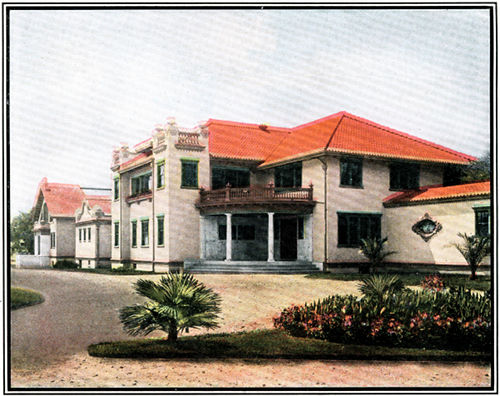
NEW BATH HOUSE AT PASO ROBLES HOT SPRINGS, PERFECTLY EQUIPPED WITH ALL THE LATEST DEVICES FOR MAKING THESE HEALING WATERS AS HELPFUL AS SCIENCE CAN SUGGEST FOR TREATMENT OF ALL AILMENTS
Salinas is the county seat of Monterey county and a big shipping point, sending vegetable products of the valley away to the markets of the world. Along here the road trends oceanward once more, the pure ozone of the Pacific, fresh blown by the never failing trade winds across thousands of miles of sparkling foam, tempers the warmth of the summer day with tonic effect and the air once again has the tang of the salt sea. Castroville is not far from it, and Hotel Del Monte’s park-like grounds 29 skirt the ocean’s shore for miles. Close by is old Monterey, where Commodore Sloat first raised the stars and stripes in California; where the constitution of the state was formulated; where to-day are some of the best preserved of the tile-roofed adobe buildings of early California. The entire Monterey peninsula, with its Pacific Grove—the Chautauqua of California—in a pine forest by the sea, amid which is set its Hotel El Carmelo; the famed Seventeen-Mile drive from Del Monte all around it, under ancient cypresses of weird form and unknown history; the Presidio of Monterey close at hand, one of the largest of government army posts; with Carmel-by-the-Sea, a picturesque colony of artistic homes clustered about the old Carmel mission—all form a wonderland for the tourist traveler, where many days, profitable and pleasant, may be passed.
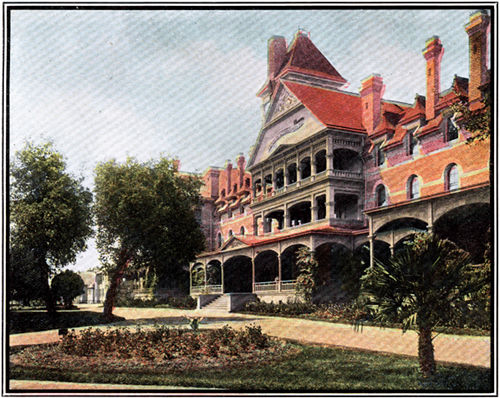
HOTEL EL PASO DE ROBLES, WHERE ARE HOT SPRINGS OF WONDERFUL CURATIVE POWER
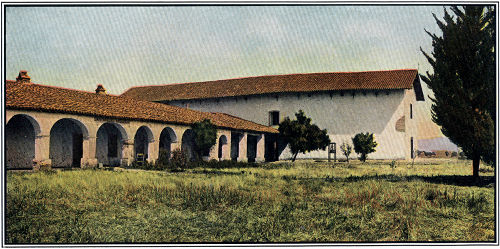
MISSION SAN MIGUEL ARCANGEL—CLOSE TO THE PASSING TRAIN—HERE, SINCE 1797, THE FATHERS OF THE CHURCH HAVE LABORED IN WELL DOING
At Hotel Del Monte one meets guests from the four corners of the earth, for the resort is one of the recognized stopping places of interest on the world’s highway. Here are all sorts of opportunities for recreation, chief among them being the eighteen-hole golf course, laid out on the oak-shaded hillside fronting Monterey bay. You can play golf here all the year. The activities of the sport never prove fatiguing nor even irksome, the temperature is never too high, cool breezes from the sea are always present, and disagreeable weather never interferes with a game. The links, only a short distance from the hotel, are the finest on the coast, if not in the country. The greens are kept in the best possible condition; water being piped to all of them and men constantly employed in cutting and rolling. All the fashionable tennis, polo and automobile clubs make Del Monte their headquarters. The race track is for gentlemen’s races, and famous events occur at intervals, summer and winter. Health and comfort, but always health, were the first thoughts of the designer of Del Monte. The advantages in and about Del Monte and Monterey are to be noted—the favorable and uniform conditions 31 of the weather, constant ozone, tonic and balsamic odors from the pine forests; excellent and unusual drainage; pure water brought in pipes from the upper Carmel river; all forming a combination not found elsewhere. The result is best shown by medical reports from the Fifteenth Infantry, lately stationed at the Presidio. In the three years’ time, among over two thousand people, only one death occurred from natural causes, and that resulting from dissipation. The winter race track at Del Monte is a mile course, and admirably suited for the accommodation of the strings of eastern horsemen. In season, salmon fishing on Monterey bay forms an exciting and popular diversion.
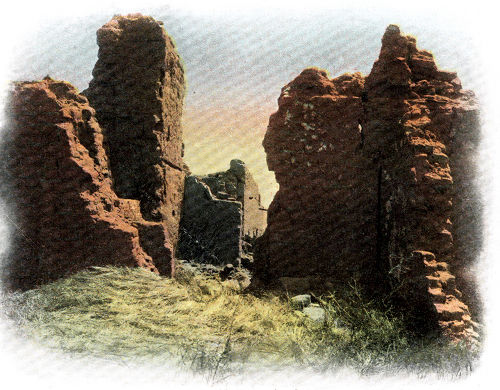
THE ROMANTIC RUINS OF SOLEDAD—THE MISSION OF SOLITUDE—FOUNDED IN 1791—HERE THE FRIARS BUILT AN AQUEDUCT EIGHT MILES IN LENGTH
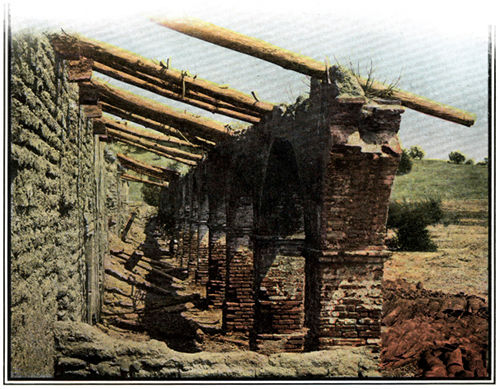
RUINS OF MISSION SAN ANTONIA DE PADUA (1771) IN THE CENTER OF A FERTILE AND FRUITFUL VALLEY
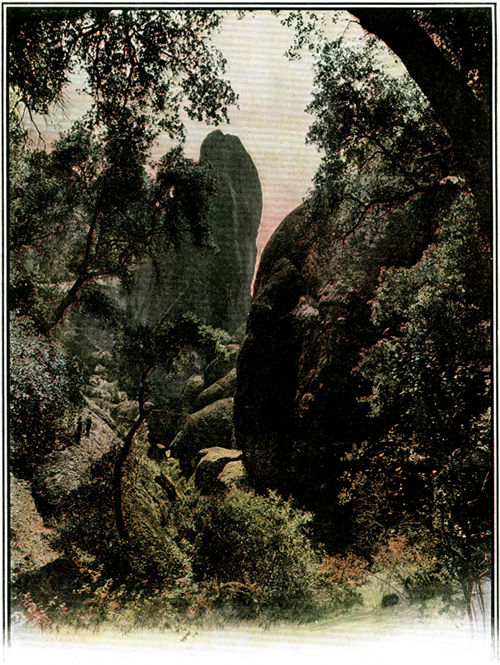
VANCOUVER’S PINNACLES—HERE IN A WONDERLAND TEN MILES SQUARE THE MOUNTAINS ARE CLEFT AND RIVEN INTO GIANT DOMES AND MIGHTY MONOLITHS, SPIRES AND TURRETS, VAST CAVES AND SUBTERRANEAN PASSAGES
All this by-the-sea region, including the coast northerly to San Francisco, is the luring ground of achievement for the photographer and artist. The art colony of Monterey and vicinity is widely known. Canvases painted here, depicting the charm of sunlight and sea, among 33 the live-oaks and the cypresses, telling the romantic story of crumbling adobes or impressions of tumbling waves on the ocean’s strand, are found in the art collections of eastern cities and the Old World. Peters, Dickman, Jorgensen, McComas, Hunter, Fonda, Gamble, Ivey, Mathews, Briggs, McCormick, are among the best known of these painters. Around Monterey bay the road passes to Santa Cruz through Watsonville and the Pajaro valley—the principal apple-producing regions of California, qualities of soil and salt air and temperature being here united to produce fruits that bring prizes at all horticultural shows.
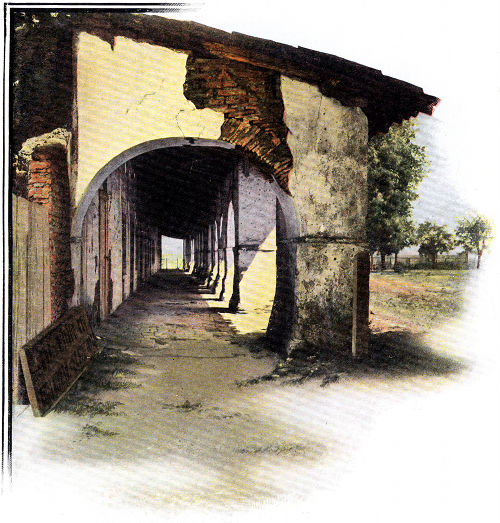
AT THE MISSION SAN JUAN BAUTISTA (1797)—THE BUILDING AND ITS ENVIRONMENT REFLECT MORE FAITHFULLY THE EARLY LIFE OF THE SPANISH PADRES THAN ANY IN THE STATE
Santa Cruz, “city of the holy cross,” is the Newport or Atlantic City of the state, with its long stretches of beach, its seaside hotels all the way from Capitola and beyond, and its attractive homes on the hillsides that look out over the ocean blue. Here, too, is a tent city, a new pavilion, casino and bathhouse, recently constructed at an expenditure of somewhere near a quarter million dollars. Crowds gather here every summer and the place is fast winning recognition as a winter resort; a modern city for health and recreation in season. Fishing sportsmen make their headquarters here, too, salmon fishing being one of the sports that attracts them here especially; the salmon being a fighting foe that makes the sport fully as attractive as tuna or tarpon in other better-known fishing grounds. Capitola, Santa Maria del Mar, Seabright, the Twin Lakes park, and other points close at hand, connected by electric railway, are all attractive spots where the idler may spend weeks of enjoyment. From Santa Cruz, northerly, the road runs through the Santa 34 Cruz mountains, a region of country homes and farms, famed for their table grapes, for their prunes and apricots and apples. The big redwood trees (sequoia sempervirens) of these mountains invariably attract the stranger. One can see many of these close by the train, but if the traveler has the time, the trip to Big Basin Park, a preserve set apart by the state, will show a forest display never to be forgotten.
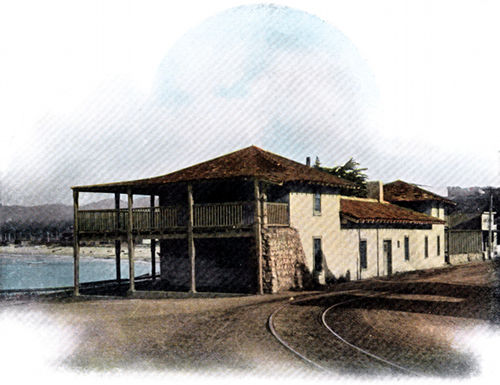
THE OLD CUSTOM HOUSE OF MONTEREY—WHERE COMMODORE SLOAT RAISED THE AMERICAN FLAG OVER CALIFORNIA
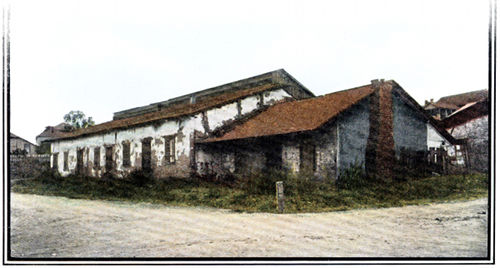
THE FIRST THEATER IN CALIFORNIA—A TYPE OF THE ADOBE BUILDINGS OF OLD MONTEREY—JENNY LIND—THEY SAY—SANG HERE IN THE ‘FIFTIES’
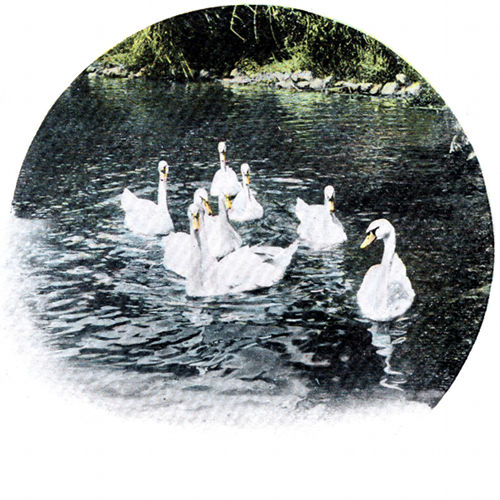
A SWAN FLOTILLA OF LAGUNA DEL REY. DEL MONTE
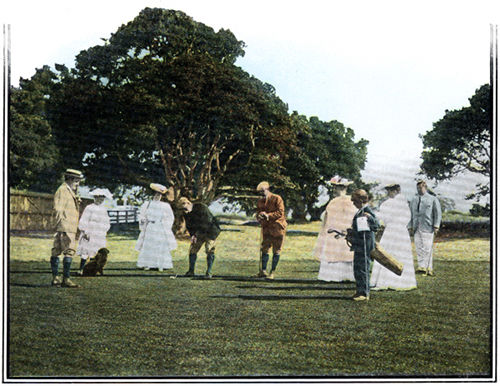
AT THE EIGHTEENTH HOLE, DEL MONTE GOLF LINKS
Keeping to the main road, northerly, from Monterey the traveler soon enters the great Santa Clara valley, passing not far from the well preserved Mission San Juan Bautista, established 1797. Through the valley, fertile and fruitful, parks of live oak and the seed farms—thousands of acres of sweet peas, of marketable bulbs, vegetable and floral—form the noticeable features. And these live oaks of California are marvelous. They are ever green like those of Palestine. Here are oaks that may have served as roofs to Indian council halls, with closely-lapping leaves that shed the rain and hide the sun, with branches that spread so wide and bow so low that they seem like great sheltering arms that both caress and protect. And then come the prune orchards, for this is the great prune producing valley of California. In Santa Clara county alone are planted more than five million prune trees. In the center of this orchard valley is San Jose, one of the oldest and most attractive cities of California. Here are excellent tourist resorts, the Hotel Vendome and the St. James, and up the mountains to the east one may see the white dome that shelters the great Lick telescope on Mount Hamilton. San Jose is a wide-awake 36 city, with smoothly paved streets, attractive parks, excellent schools and all advantages of a cultured up-to-date community, including electric railroads and libraries.
From San Jose the road continues through the Santa Clara valley, up the San Mateo and San Francisco peninsula, one of the most attractive sections of California. Here are more suburban residences, some with vineyards and orchards, all with superbly kept lawns. Palo Alto is the site of the Stanford University, a marvel among the colleges by reason of its rapid development, its wonderful endowment, aggregating $30,000,000, and its superb equipment of buildings and men. Burlingame, San Mateo and Redwood, fill for San Francisco much the place that Lenox or Brookline do for Boston with people of wealth and culture.
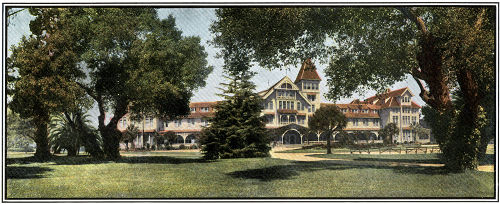
HERE IS A PICTURE OF HOTEL DEL MONTE AND ITS GROVES AND GARDENS AS THEY APPEAR AT CHRISTMAS TIME
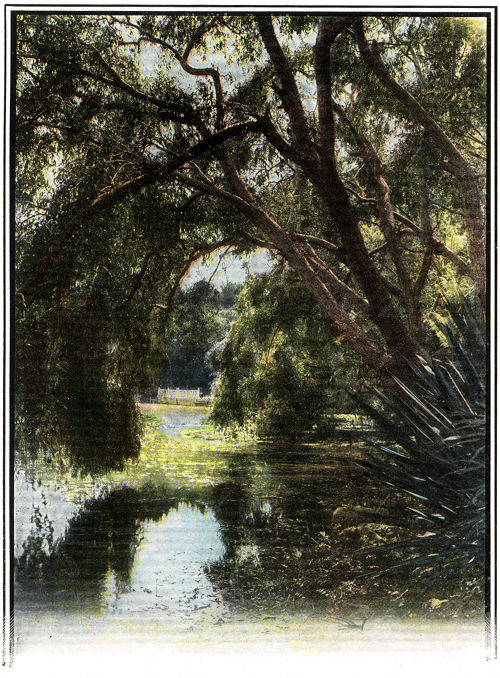
LAGUNA DEL REY ONE OF THE CHARMS OF THE HOTEL DEL MONTE’S FAMOUS GROUNDS—HERE SWANS FLOAT WITH GRACEFUL DIGNITY AND CHARMING VISTAS AND REFLECTIONS MEET THE EYE IN EVERY DIRECTION
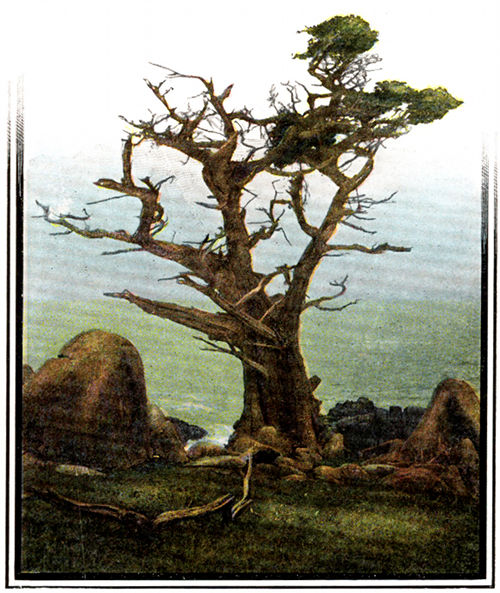
AN ANCIENT CYPRESS TREE ON THE PACIFIC GROVE PENINSULA
In San Francisco—righting itself rapidly since the great disaster of April 18-20, 1906—one may readily pass two weeks or more in diversified pleasure, entertainment and instruction. Here is a city of 500,000, eighth among the cities of the United States at the last census and in line for sixth place. Everywhere the demands of trade and of modern civilization are crowding the city. In its harbor the ships of war of all the nations of the world could float, with room and to spare. The climate welcomes the health-seeker and the man who would live out of doors all the year. The fast-growing city, with buildings going up everywhere to replace those lost in the big fire, is the heart of the state. Real estate sales and clearing-house figures, assessor’s valuations, all show the city’s present progress. Still westward across the Pacific to the Philippines, to Japan, to the Orient; southerly to Hawaii, to Tahiti, New Zealand, Australia; northerly to British Columbia, the Alaskan archipelago, Cape Nome, and the gold region of the Klondike, the advancing commercial movement tends. In the nine months following the disaster, to February 1907, building permits aggregated $40,128,753, while bank clearings have gained steadily, amounting for example to $204,512,323 for January, 1907, compared to $185,519,862 for January, 1906. Here most decidedly is a city of destiny. Here is the soft air and 38 blue sky of Italy, the views of Naples, the hills of Rome, the winter climate of the Riviera, and people who, in the face of severest stress have shown themselves possessed of the combined attributes of New England energy and Oriental luxury.
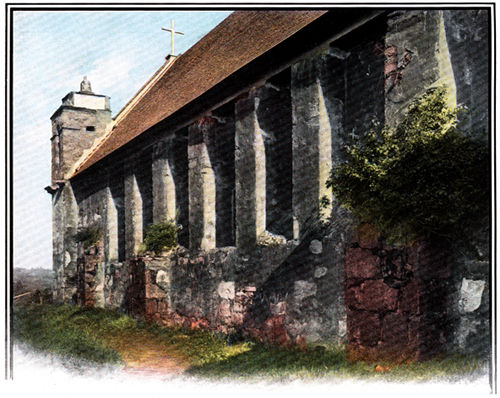
MISSION SAN CARLOS DEL RIO CARMELO. NEAR HOTEL DEL MONTE AND CARMEL-BY-THE-SEA
Things are moving here, and busy men are learning only of progress, of advances in value, of chances for investment while over all and around all, is a climate of comfort, of chances for out-of-door exercise and daily pleasures all the year round. Here is sunshine almost every day; here one can utilize every moment for business or pleasure. The Weather Bureau records show that the city averages 294 sunshiny days a year.
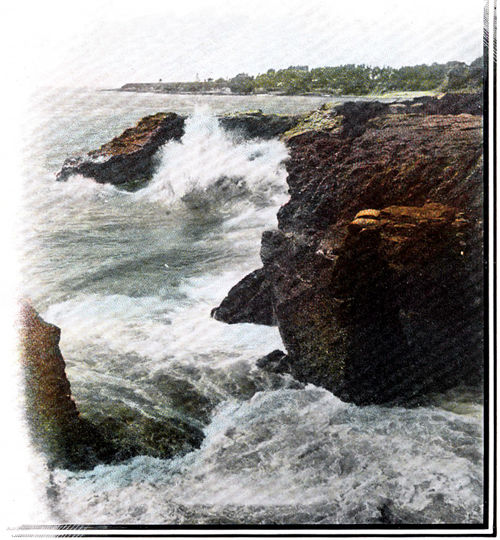
SANTA CRUZ BOASTS A FAMOUS ROADWAY—THE CLIFF DRIVE
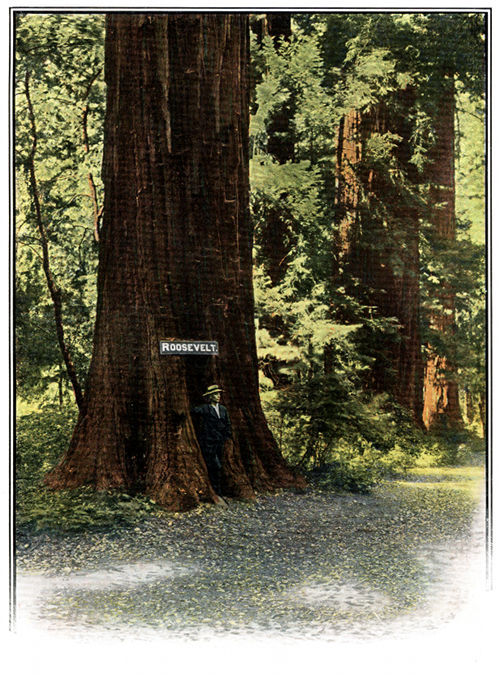
AMONG THE BIG TREES OF THE SANTA CRUZ MOUNTAINS—ALL OF THE TREES IN THIS GROVE BEAR DISTINGUISHED NAMES
In the forest, sweet
The shade, the peace! Immensity that seems
To drown the human life of doubts and dreams.
—SILL
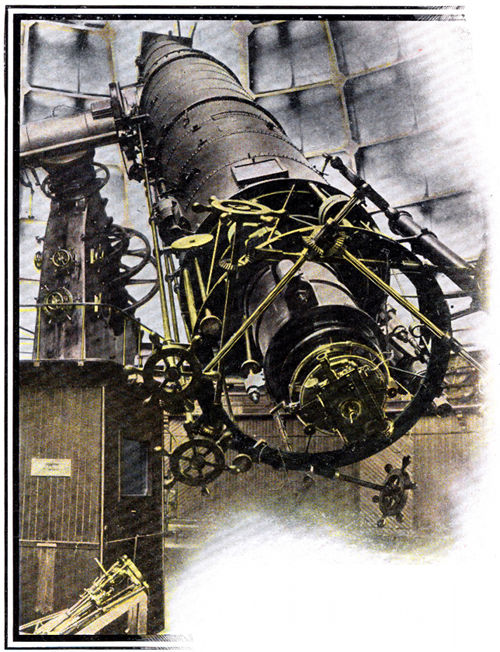
LICK OBSERVATORY’S GREAT TELESCOPE—THIS LENS IS THREE FEET IN DIAMETER AND THE SECOND LARGEST IN THE WORLD
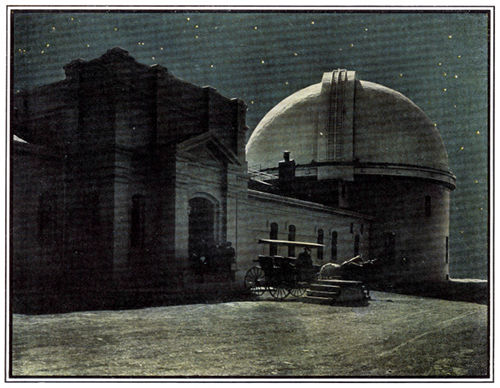
THE PLACE TO SEE OTHER WORLDS IF YOU ARE TIRED OF THIS ONE—THE LICK OBSERVATORY ON MOUNT HAMILTON
For all of California’s richness, San Francisco is the centering point. It is upon the west shore of San Francisco bay, a land-locked harbor that has been both the pride and marvel of navigators ever since Lieutenant Juan De Ayala, in August, 1775, sailed in to the harbor through the Golden Gate and told the world of its wonders. The coming of the padres and the founding of the Mission was the virtual founding of the city, for about the Mission soon grew the small settlement of Yerba Buena. Then on January 19, 1848, came the discovery of gold. Within two years over 100,000 adventurous men came, and many remained to help upbuild San Francisco and California. Across the bay on the eastern shore is Oakland, third city on the coast, with its 175,000 people. It is a city of slopes covered with charming homes, spreading northward to the city of Berkeley, seat of the great University of California and noteworthy for its loveliness. Southward and adjoining is Alameda. These sister cities perhaps unexcelled in the world as a residence section, are now assuming great business importance also. San Francisco’s commerce increases steadily. In the great fire of April, all the water front with the wharves and steamer docks, was untouched. The harbor of San Francisco is a wonder among harbors, the bay and its connections extending north and south for about forty miles, affording anchorage for the merchant fleets of the world. It is entered through the Golden Gate, a passage five miles long, and one mile in width at its narrowest portion. These straits within recent years, 1890 to 1904, have been fortified with the most approved ordnance, and the fortifications are recognized by military experts as among the best defenses of any city of the nation. Within the bay, several islands are controlled by the government and fortified, while at the Government Navy Yard, and at Mare Island, north of the city, and at the Union Iron Works, on the peninsula, are docks capable of receiving modern warships. Here at the Union Iron Works have been built some of the crack ships of the navy, including the cruisers Charleston, San Francisco, Olympia, the battleships Oregon, Ohio, South Dakota, Wisconsin, and a number of smaller craft.
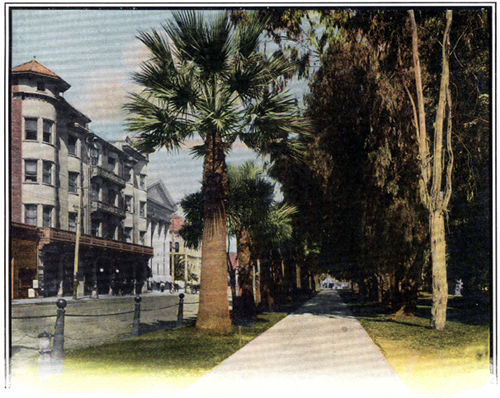
THE CITY OF SAN JOSE HAS MANY MILES OF SMOOTHLY PAVED STREETS AND ELECTRIC RAILWAYS—THIS IS ONE OF THE MAIN THOROUGHFARES WITH ST. JAMES’ PARK, A SHADY GARDEN SPOT, TO THE RIGHT
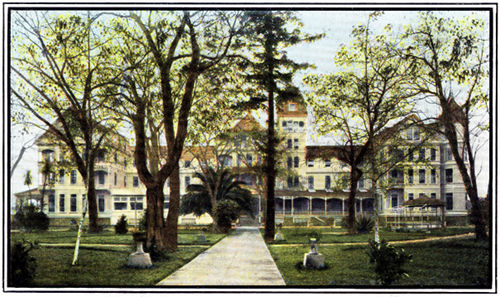
HOTEL VENDOME AT SAN JOSE, WHERE YOU CAN SPEND ANY DAY OF THE YEAR WITH COMFORT INDOORS OR OUT
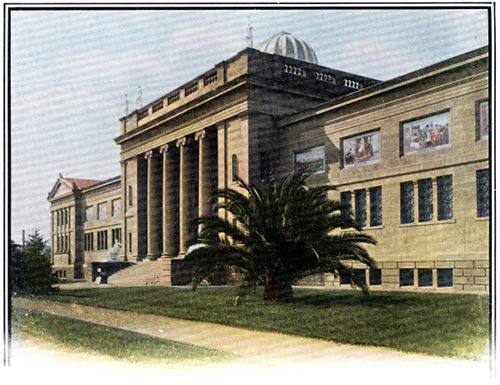
THE MUSEUM—LELAND STANFORD JR. UNIVERSITY AT PALO ALTO
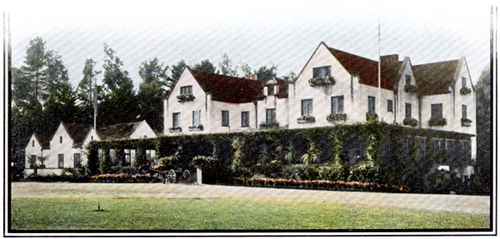
THE BURLINGAME COUNTRY CLUB—CALIFORNIA’S FAMOUS RENDEZVOUS FOR OUT-OF-TOWN FUNCTIONS—POLO IS ONE OF ITS GREAT RESOURCES
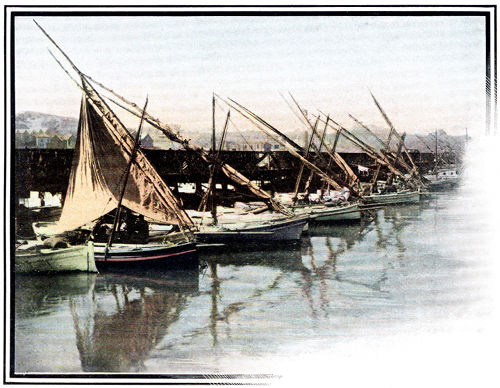
BENEATH THE BLUE OF SAN FRANCISCO SKIES THE ITALIAN FISHERMEN’S PICTURESQUE CRAFT HELP TO MAKE CLEAR THE CITY’S TITLE—THE NAPLES OF THE PACIFIC
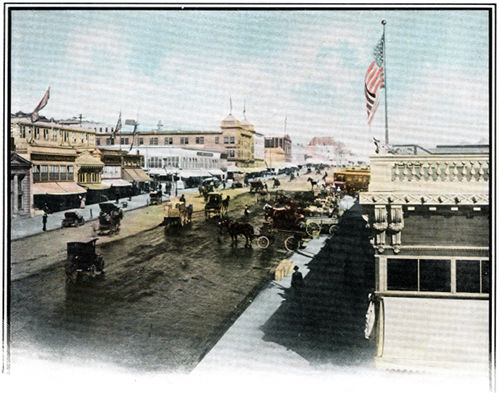
VAN NESS AVENUE, SAN FRANCISCO’S NEW SHOPPING THOROUGHFARE—THE STORES, WHILE OF HASTY DESIGN, HOLD WARES RIVALLING THOSE OF ANY METROPOLIS AND THE AVENUE ITSELF IS A FASHIONABLE RESORT FOR BOULEVARDIERS
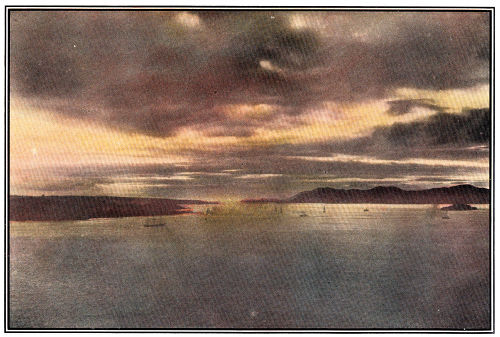
LOOKING WESTWARD THROUGH THE GOLDEN GATE
As Vesuvius is to Naples, so is Tamalpais to San Francisco, though the menace is missing, the crater no longer shows the signal cloud of sullen fires. Its extinct volcanic summit rears itself 2,590 feet above sea level, as one looks across the bay from the city. Up its slopes runs a railway that is a marvel of engineering construction. It’s quite the popular thing to hie away to the eyrie tavern on the crest of this mountain, there to be alone with the sea and sky and one’s thoughts. Gertrude Atherton’s latest novel was written amid these surroundings. Around the base of this mountain are sheltered slopes on which are the homes of San Francisco residents; across the bay, by Oakland, Berkeley and Alameda, the home district runs.
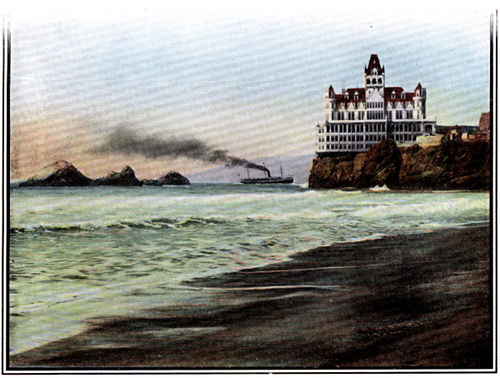
EVERYONE HAS HEARD OF SAN FRANCISCO’S CLIFF HOUSE AND THE SEAL ROCKS—HERE, EVERY HOLIDAY, GAY CROWDS PICNIC ON THE SANDS, BATHE IN THE BREAKERS AND WATCH THE SPORTIVE SEA LIONS
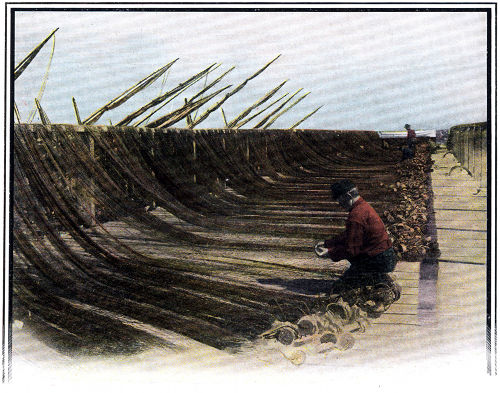
“TO-MORROW WILL BE FRIDAY”—GREEK FISHERMEN MENDING THEIR NETS
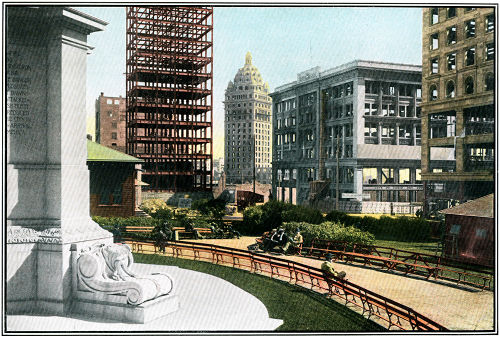
UNION SQUARE—SAN FRANCISCO, THE CENTER OF THE BUSINESS SECTION, WHERE RAPID RECONSTRUCTION HAS ALREADY PROVIDED THE NUCLEUS OF THE NEW CITY
Heading northerly, crossing San Francisco bay, the road skirts the eastern shore passing Selby’s where gold quartz is transformed into bullion; the Mare Island Navy Yard, the naval center of the coast; by big grain-shipping warehouses and across Carquinez straits. The train at this point goes upon a monster ferry that carries it over the swift inflow of the Sacramento river. Here at Benicia is the government arsenal, then comes the duck country—the famous Suisun marshes. Across the straits from Benicia shows the summit of Mount Diablo, 3,849 feet, meridian base for this region. Near by, are the fruitful San Ramon and Alhambra valleys. Close by is Byron Hot Springs, a famed resort for invalids. Along the shore of the Sacramento river is Stockton, famed for its manufactures, also the towns of Vacaville, Woodland and Winters, all of them thrifty and rapidly growing centers of California’s fruit industry.
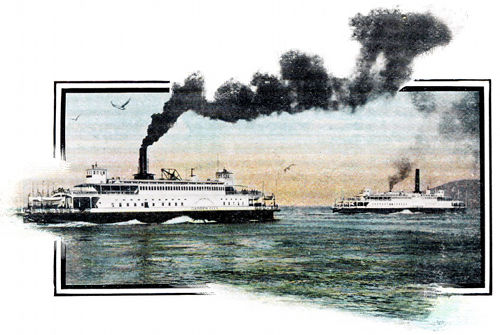
THE FERRIES THAT PLY ACROSS THE BAY OF SAN FRANCISCO FORM A CHARACTERISTIC PICTURE
At Sacramento, the capital of California, one may spend a few days enjoying the soft air, the semi-tropical foliage, the orange and the olive and the palm, or perhaps getting a glimpse of Sutter’s Fort, notable in California history. It was to this point that John Marshall brought in January, 1848, the news, so soon to travel far and wide, of the discovery of gold in the millrace at Coloma. The fort is now a museum maintained by the orders of the Native Sons and Daughters of the Golden West. Here are stored reminiscences of the past; among them an old stage coach, riddled with bullets—placed there by ambitious highwaymen, and a prairie schooner with its old equipment reminds one of early overland history.
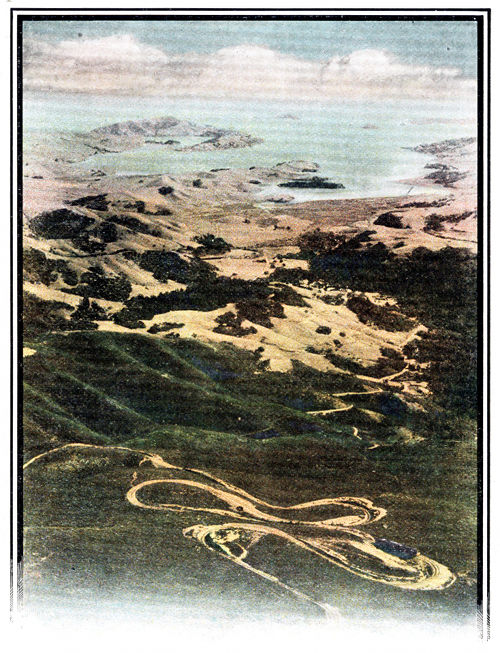
UP THE INCLINE OF THE CROOKEDEST RAILWAY IN THE WORLD—CLIMBING MOUNT TAMALPAIS
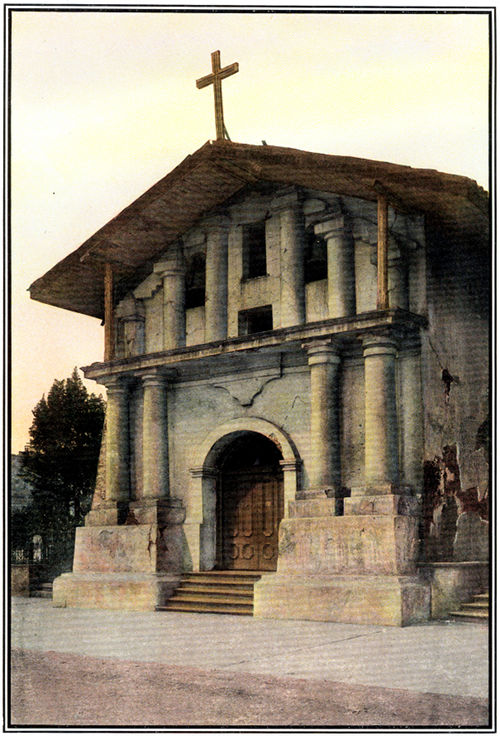
THE MISSION DOLORES, SAN FRANCISCO—ESTABLISHED 1776
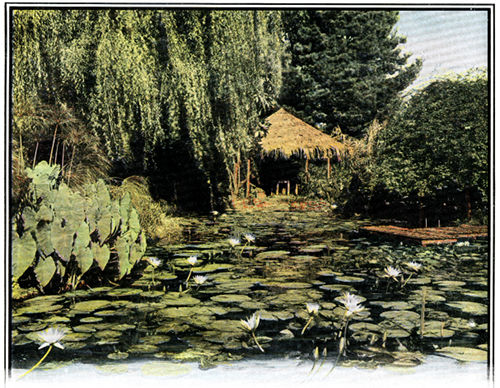
THIS IS A LILY POND IN THE GROUNDS OF ONE OF OAKLAND’S FOREMOST RESIDENTS
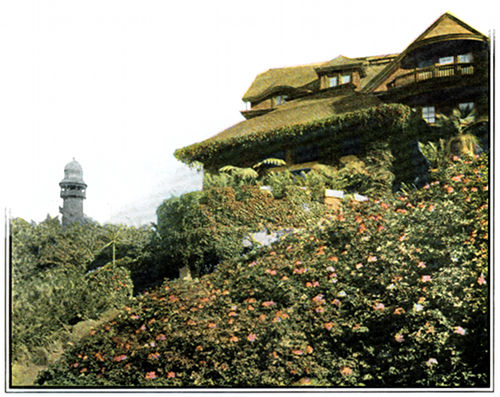
ON THE FOOT-HILLS OF THE COAST RANGE IN OAKLAND, ACROSS THE BAY FROM SAN FRANCISCO, ARE MANY BEAUTIFUL HOMES—HERE IS ONE OF THEM
Sacramento is a modern city with many miles of electric railway and paved streets running out to suburban orange and olive groves in the attractive suburbs, and past the capitol building and surrounding park. In the Crocker art gallery, established more than thirty years ago by Judge E. B. Crocker and Mrs. Crocker is a notable collection of paintings well worth the time of inspection by the art connoisseur. In this gallery of seven hundred paintings, chiefly by foreign artists, are to be found some of the canvases of Van Dyck, Murillo, Guido Reni, Salvator Rosa, Correggio, Tintorretto, Leonardo da Vinci, Luini, Sir Peter Lely and others, and some fine examples from 50 Piloty, Kaulbach, Thomas Hill and other modern masters. In addition, are many folios of inestimable value, containing original drawings from old and modern masters which were secured from the studios and collectors in Europe during the Franco-Prussian war. There is also exhibited in the building a large and valuable collection of minerals, in cabinets, the property of the state of California. The gallery is open every day.
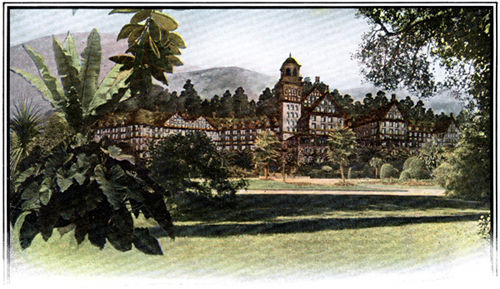
THE CLAREMONT THE BEAUTIFUL HOTEL OF OAKLAND—BERKELEY
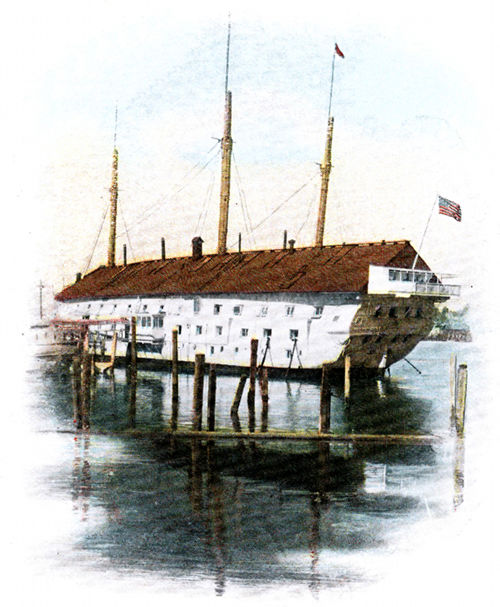
IN TIME OF PEACE PREPARE FOR WAR—DRILLING BLUE-JACKETS AT MARE ISLAND NAVY YARD
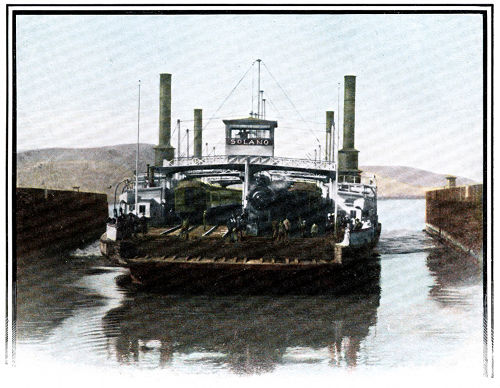
CROSSING CARQUINEZ STRAITS—THE SOUTHERN PACIFIC FERRY BOAT “SOLANO.” THE LARGEST TRAIN FERRY IN THE WORLD
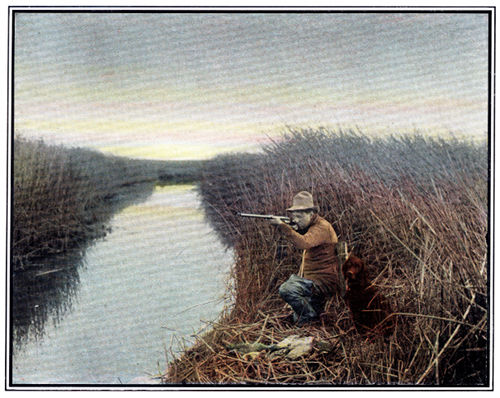
THE DUCK SHOOTING ON THE SUISUN MARSHES IS FAMOUS—MANY PRIVATE GUN CLUBS HAVE THEIR PRESERVES HERE AND RECORD BAGS OF SPRIG AND MALLARD, TEAL AND CANVASBACK ARE SELDOM WANTING
From Sacramento there are numerous side-trips up into the gold mine region of California, to Grass Valley, Oroville, Placerville—regions that are known largely through the fascinating writings of Bret Harte. Around Oroville and along the Feather river may be seen that marvel of gold mining, the electric dredger. These monster burrowers are here eating their way steadily into the gold-bearing soil. In many places this work is going on industriously in the center of profitable bearing orchards, but the gold from within is found by this process to yield to greater profit than the golden fruit produced by trees on the surface. And then from Sacramento the great valley broadens out. To the north is the vast orchard region of Sutter county, and the great granaries of Colusa, Glenn and Tehama counties; south of the city, and close by, is the slough country, where in the fertile, fruitful ground—fertile as the valley of the Nile or the rich dike-inclosed country of Holland—are vast stretches given up to vegetable growing, especially of asparagus, celery and potatoes. This valley of the Sacramento is an empire with many principalities. Such a region in the Old World or in the New England or Middle States would have been as populous as the valleys of the Loire, or the Housatonic, or Susquehanna long before this. The foothill counties, tributary to the great interior valley, are rich in gold and other minerals. The value of these streams, snow-fed, coming down to water the valley is fully appreciated, and power generated on the south fork of the Yuba river is used to-day to run the electric railways of cities by the bay—over 220 miles away. Off here to the right, beyond Marysville, as well as on through the Sierra slopes, is the early orange producing region; oranges go east from this section before Thanksgiving, and practically the whole crop is shipped by Christmas. The counties of this valley yield annually over one half of the entire output of the deciduous fruits of California. At Chico is the home of the late General Bidwell, Rancho Chico, another one of California’s principalities. Here at Chico is the plant introduction garden and station of the United States Department of Agriculture, chosen for its wonderful advantages of soil and climate.
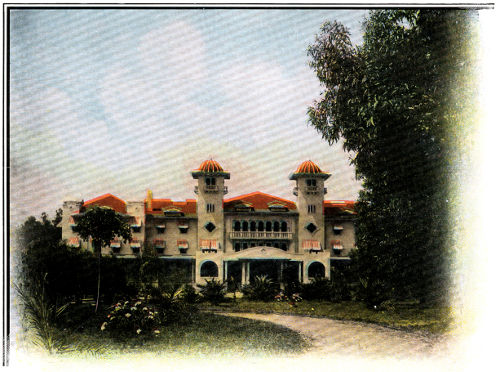
HOTEL AT BYRON HOT SPRINGS—ANOTHER ONE OF NATURE’S SANITARIUMS
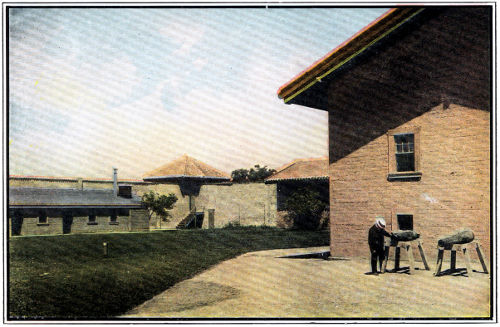
WITHIN THE PALISADE OF SUTTER’S FORT, BUILT BY GENERAL JOHN A. SUTTER ABOUT 1830
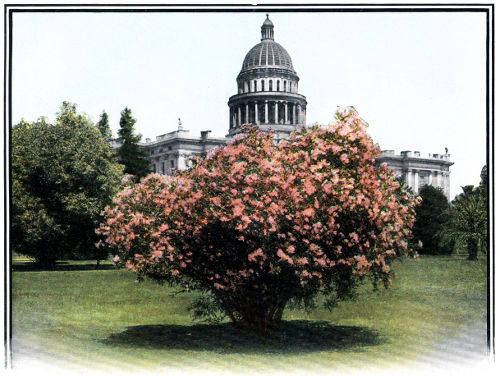
THE CAPITOL AT SACRAMENTO—VARIETIES OF HUNDREDS OF RARE AND SEMI-TROPIC TREES AND FLOWERS ORNAMENT THE SPACIOUS GROUNDS
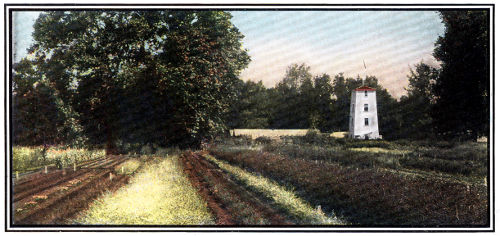
NEW PLANTS DISCOVERED WHILE YOU WAIT—GOVERNMENT PLANT INTRODUCTION STATION AT CHICO
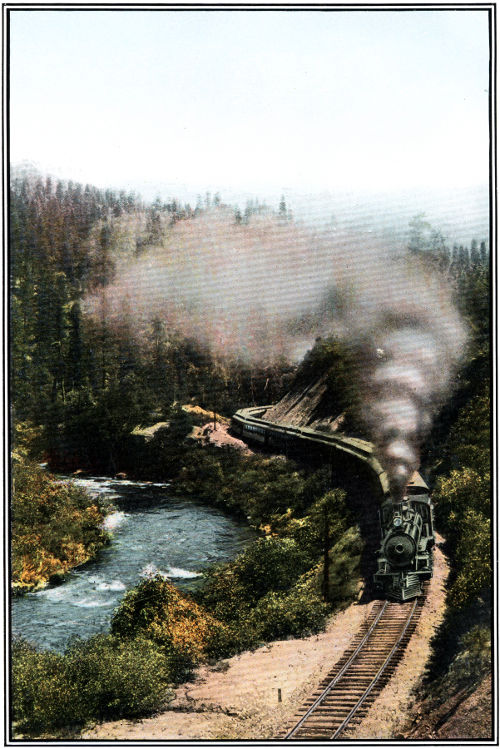
IN THE CAÑON OF THE UPPER SACRAMENTO—WHERE EVERY CURVE DISCLOSES SCENES OF ENTRANCING BEAUTY
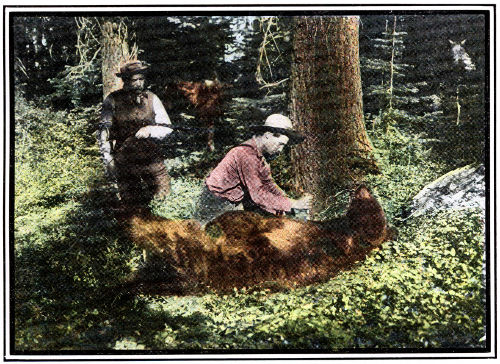
A NOT UNUSUAL SCENE—VICTORS OVER A WORTHY FOE
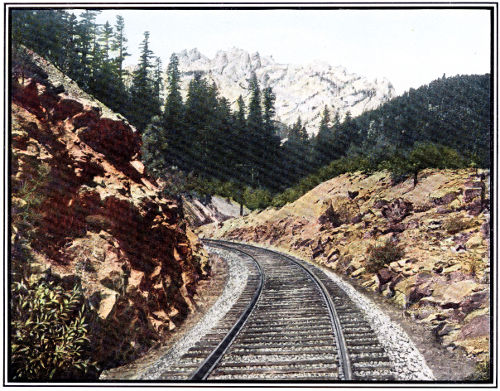
CASTLE CRAGS—VOLCANIC PALISADES ON THE SHASTA ROUTE
And then on, up the Sacramento valley, northerly, the road goes through Tehama, Red Bluff, and Redding—prosperous young cities, centers for rich mines, vast grain fields, orchards and sugar-pine forests; carrying the traveler through a region of marvelous scenic value—Castle Crags, Shasta Springs, with its crystal water bubbling up near the track, and peerless views of snow-capped Shasta. Here are opportunities for fishing and hunting and genuine alpine mountain climbing, for scaling the summit of Shasta is to western sportsmen more or less of a duty, much as that which lures the Alpine traveler to climb the Jungfrau. For this task of muscular devotion, travelers should stop off at Sisson, where there is a snug inn, open 56 winter and summer, where mountain climbing parties can be supplied readily with a full equipment of things needful for the not difficult ascent.
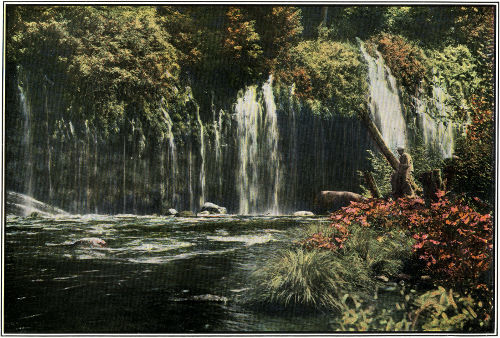
MOSSBRAE FALLS, OPPOSITE THE TRACK NEAR SHASTA SPRINGS ON THE WAY BETWEEN SAN FRANCISCO AND PORTLAND
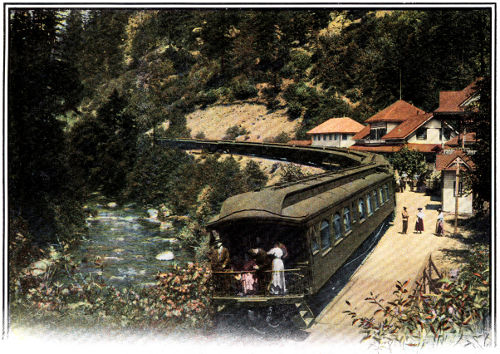
AT SHASTA SPRINGS WHERE ONE OF NATURE’S FOUNTAINS BOILS UP CLOSE BY THE RAILWAY—AN ALL-YEAR-AROUND RESORT
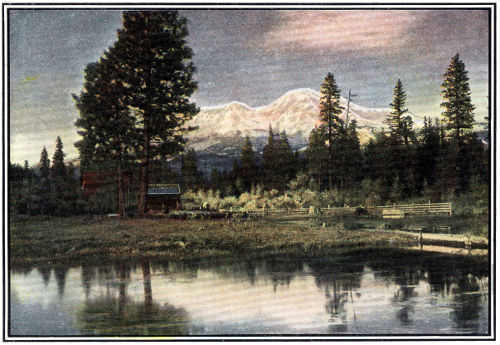
SNOW-CAPPED MOUNT SHASTA 14,444 FEET. ONE OF THE WORLD’S WONDERS
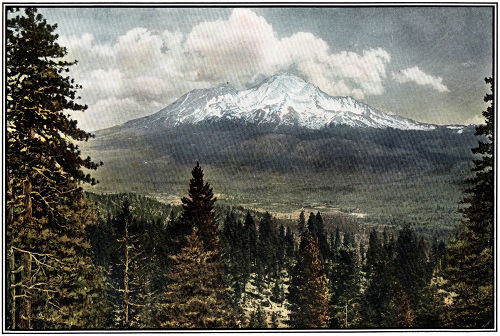
FOR MILES THE TRAVELER KEEPS IN VIEW THE SNOWY SUMMIT OF SHASTA. EACH CHANGING PICTURE ATTRACTIVE, IMPRESSIVE AND ENDURING
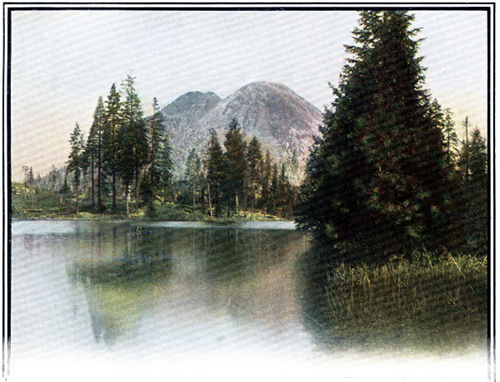
MUIR’S PEAK, NEAR SISSONS, ONE OF THE VOLCANIC CONES THAT MAKE THIS REGION FAMOUS FOR ITS SCENIC BEAUTY
And then on and up, over into Oregon, across the Klamath river, that temptingly points out the way to the Klamath lakes and other hunting grounds, so vast and so filled with game worth pursuing, as to make the Adirondacks seem like a children’s play-ground in comparison. Away from the road, near here, too, is Crater lake, that wonder of wonders; a lake of crystal pure water resting upon the crest of an extinct volcano, without inlet or outlet.
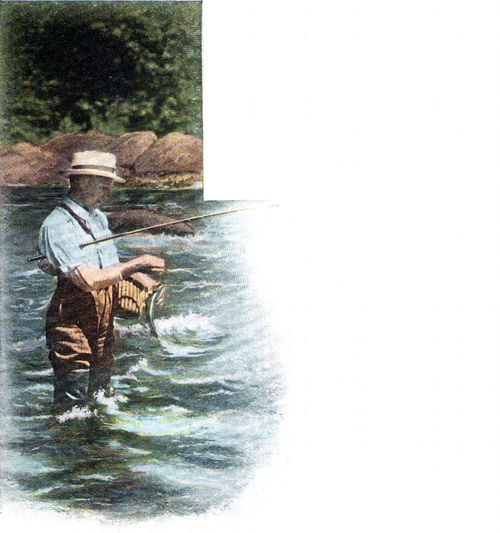
WHAT SPORTSMEN MAY FIND IN A THOUSAND CAÑONS OF SOUTHERN AND WESTERN OREGON
On the train goes, winding and twisting on and upward and downward, into Oregon through the cañons of the Siskiyou range, with the never-to-be-forgotten sight of the fertile valley of the Rogue river, with farmhouses that look like New England, with their white paint and green blinds; with fruitful orchards, long stretches of green fields, glimpses of mining operations, and always mountains and forest, and forest and mountains, near and far. Here, in southern and eastern Oregon, is a comparatively new paradise for the sportsman, and a wondrous scenic region. Here are chances for stop-over trips, long to be remembered, with prospects of big game trophies that will afford countless texts for hair-raising stories at home.
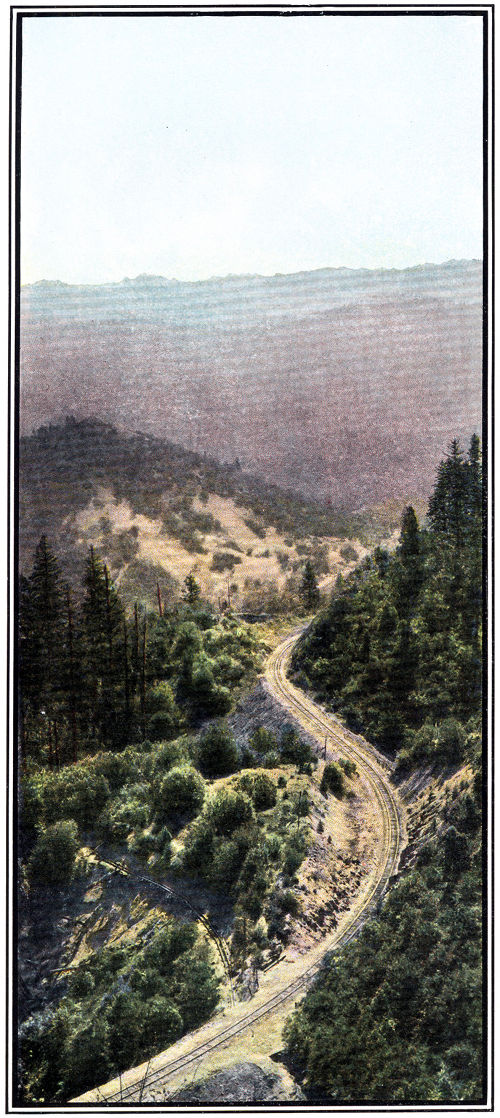
OVER THE SISKIYOUS INTO OREGON THROUGH MOUNTAIN SCENERY OF STUPENDOUS GRANDEUR
This Rogue river valley country, of which thriving Ashland and fast-growing Medford—cities of stone and brick—are the centers, sends broadcast, annually, thousands of boxes of the finest apples, pears and peaches. These rolling valleys and forest clearings make an unexcelled fruit and farming country. Jacksonville, off to the west, is on the old California trail; the first gold discovery of Oregon was near here, on Jackson creek. Over this trail, which the railroad closely follows, traveled adventurous trappers and hunters, and after that, the gold seekers, before the days of wagon-roads or railways. The road skirts the red waters of the Rogue—originally called Rouge by French-Canadian trappers of the Hudson’s Bay Company—as far as Grant’s Pass, a bustling city that is the center of a rich lumber, gold and copper mining and farming country. The Rogue and its tributaries, like other Oregon rivers, are fast flowing and 61 never failing streams, with rapids and waterfalls at frequent intervals, fringed by forest trees that help make pictures at every turn. Here, at Gold Ray, an enterprising electric power company has developed tremendous power, which will be used for the many mining industries, as well as in the progressive ranches and homes, through all this region.
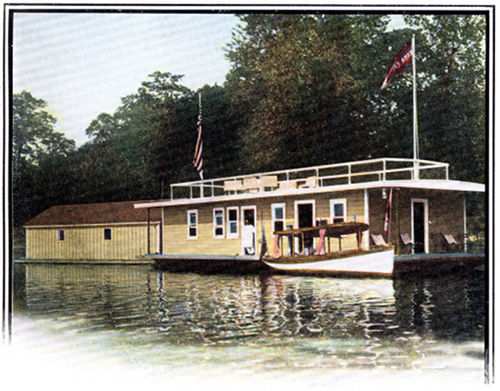
HOUSE BOATING ON THE WILLAMETTE, WITH ITS CLEAR WATERS, ITS WELL TIMBERED AND PICTURESQUE SHORES, IS A JOY OFTEN INDULGED IN BY MANY OREGONIANS
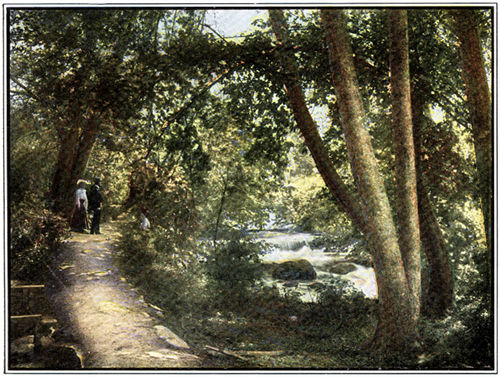
ALONG ASHLAND CREEK ARE MANY SCENES RIPE FOR AN ARTIST’S CANVAS
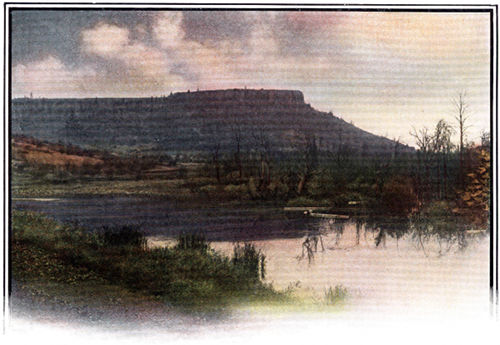
TABLE ROCK ON ROGUE RIVER HAS BEEN A STRIKING LANDMARK SINCE MAN FIRST TRAILED THIS COUNTRY
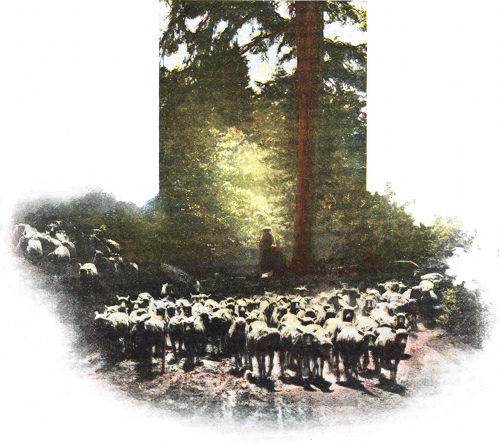
SHEEP RAISING IS AN IMPORTANT AND GROWING INDUSTRY OF OREGON
Around Roseburg, about two hundred miles southerly from Portland, are vast forest resources, with outlying valleys and cañons and mines and farms that help to make this a thriving place. Long before reaching here the road crosses and recrosses the Umpqua river, which flows through its fertile valley northwesterly into the sea. At Cottage Grove, as at other points along here, there are more signs of Oregon’s rich mines, signs of the placer camps of early days, as well as of the more recent developments in quartz mining. The records show that gold to the amount of $120,000,000 was washed from the streams of Oregon during the early ’60s. During recent years there have been many gold strikes, and to-day all through these ranges prospectors and expert agents for mining capitalists are searching and locating the precious metal. The famous North Pole mine, for example, ranks among the largest and is valued at over fifteen million dollars. At Cottage Grove, the road first touches the picturesque Willamette river, following its course to Eugene—seat of the University of Oregon—crossing it at Junction City, touching it again at Albany—a big shipping point for luscious Oregon prunes; again at Salem, the state capital, a city of 15,000 people, and at Oregon City.
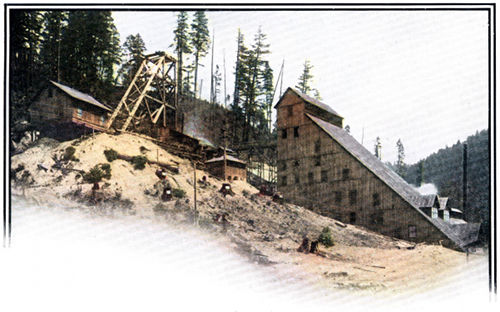
THE GRANT’S PASS MINE—IN THE CENTER OF A RICH GOLD AND COPPER DISTRICT
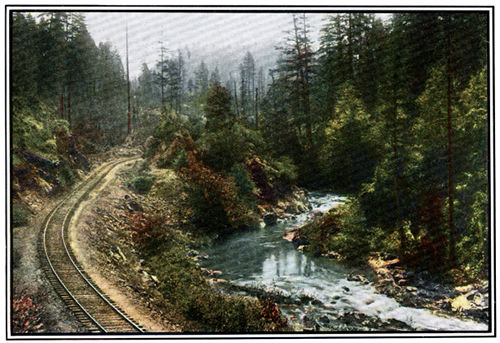
COW CREEK CAÑON NEAR WEST FORK—ALL DOWN THE RAVINE THE TORRENT RACES IN RAPID RIVALRY WITH THE TRAIN
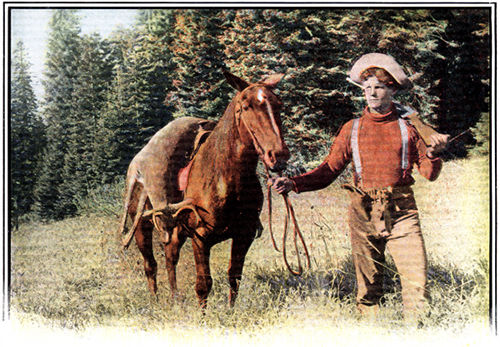
WHAT SPORTSMEN MAY FIND IN A THOUSAND CAÑONS OF SOUTHERN AND WESTERN OREGON
At Oregon City are the falls of the Willamette, where the power of the river is harnessed for the use of many factories. A ship canal has been built around the falls. The Willamette valley is one of the most fertile and most beautiful river regions of any land, stretching southward from Portland across eight counties and occupying four million acres of rich land. It is a natural center for dairying and diversified farming. A total failure of crops has never been known.
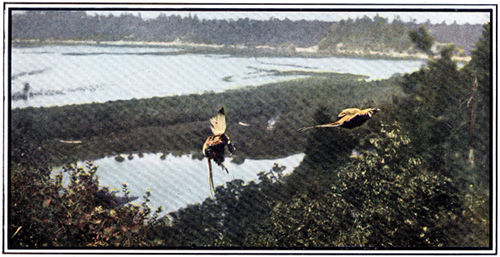
SHOTS, PHOTOGRAPHIC AND OTHERWISE, AT THE OREGON PHEASANT: THE PRETTIEST, PROUDEST AND GAMEST OF ITS TRIBE
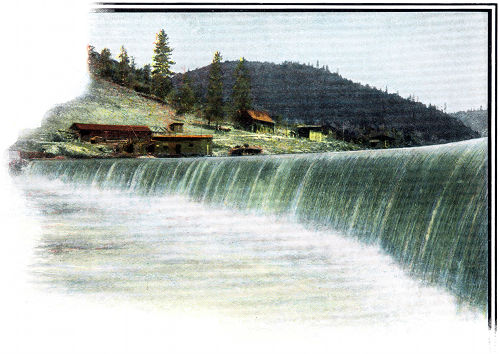
HERE THE CONDOR POWER COMPANY HAS HARNESSED THE SWIFT FLOWING ROGUE
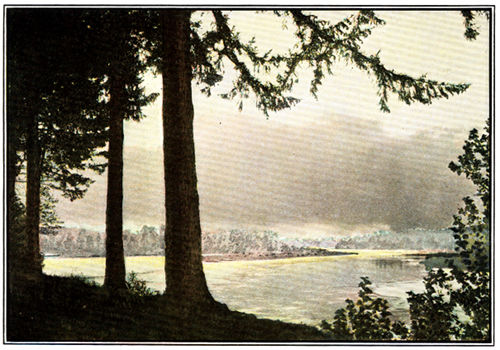
THE WATERS OF THE WILLAMETTE MIRROR MANY PEACEFUL SUNSETS
The Willamette itself is broad and swift flowing, with banks lined with forest trees of perpetual verdure. From north to south the river meanders, now lazily, now with a rush of leaping waters. It passes through a delightful pastoral country where the farmhouses are framed in fruit orchards and sleek cattle feed by the river pastures. Now and then the banks rise sheer in tree-crowned cliffs fifty feet in height. There are plenty of fish and wild life abounds. There are many canoe clubs at Portland and during the summer the Willamette is crowded with the fleet of light craft while trips up and down the river are in great favor, sometimes extending for days and covering a voyage of one hundred miles, the distance by river between Portland and Albany. From Portland to Salem the capital city, a steamer plies the fifty miles of waterway. House boats, often of luxurious design, are in high favor on the quieter reaches.
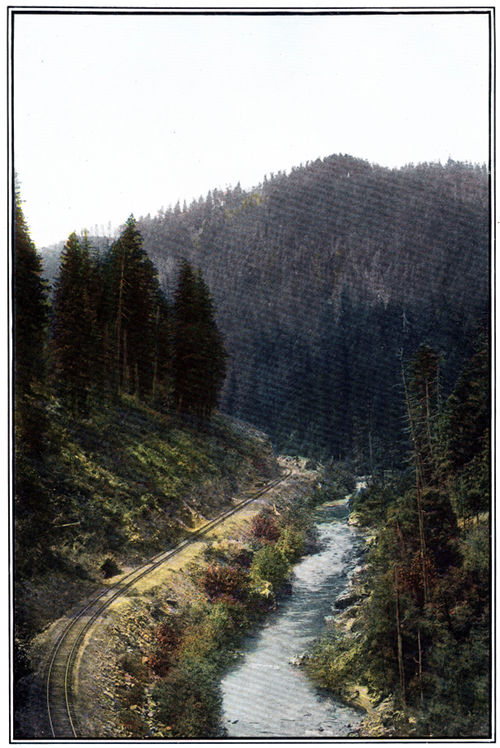
COW CREEK CAÑON, DESPITE ITS UNROMANTIC TITLE. HAS FEW RIVALS IN ITS PICTURESQUE BEAUTY
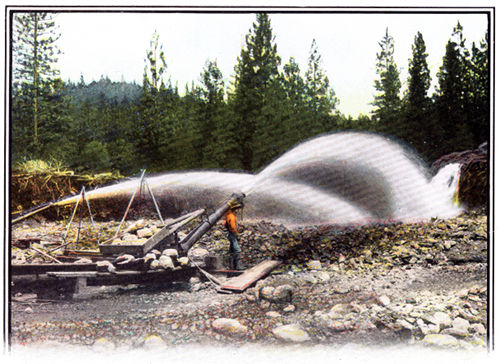
PLACER MINING IN SOUTHERN OREGON, WASHING DOWN THE GOLD GRAVELED BANKS
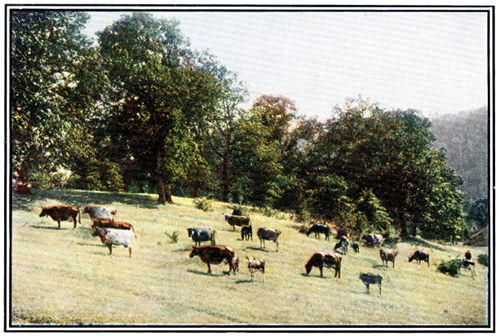
A TYPICAL SCENE IN PASTORAL OREGON THAT RECALLS THE BERKSHIRE HILLS
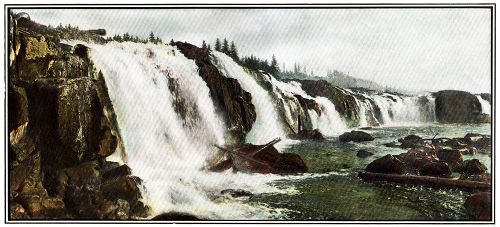
THE FALLS OF THE WILLAMETTE
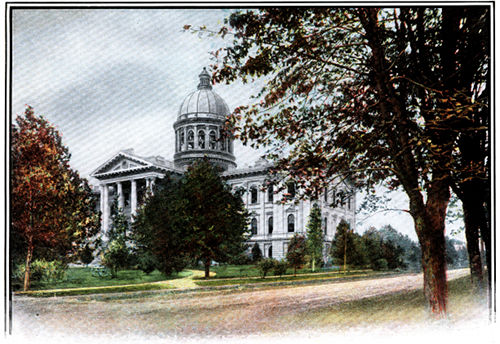
OREGON’S CAPITOL IS AT SALEM, A CITY OF FIFTEEN THOUSAND
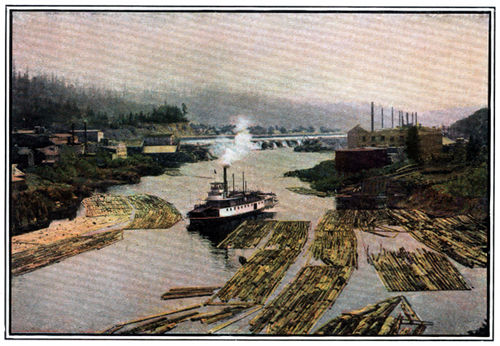
ON THE WILLAMETTE NEAR OREGON CITY, MANY MILLS AND FACTORIES ARE RUN BY POWER FROM THE FALLS
At Portland, near which the Willamette joins the Columbia, it becomes the city’s harbor from which the average outgoing cargo runs up to seven thousand five hundred tons. Portland, the “rose city,” where roses bloom in profusion on Christmas day, came prominently before the public eye of late with the centennial celebration of the great overland journey of the explorers Lewis and Clark. It is a beautiful city, superbly situated, with surroundings that suggest wealth and culture, and promises everywhere for a glorious future. The streets, outside the business quarter, are shaded by overarching trees and lined with beautiful villas set in green lawns and flower beds of riotous, fragrant bloom. From Portland Heights, reached by the car lines, the panorama is superb, the view including Mount Rainier, a hundred miles away to the north, with the blue barrier of the Cascades 70 stretching to Mount Jefferson, a hundred miles to the south, snow-clad Mount Saint Helens and Mount Hood, the Columbia river and its giant gorge, the tributary Willamette and the green of the nearer low-lands, gleaming here and there with the lakes of the Columbia valley; a prospect declared by Caspar Whitney, to be the grandest and most interesting in natural beauty he had ever seen. Higher yet is Council Crest, once a favored place for Indian conferences, fifteen hundred feet above the city; reached by the street cars; the projected site of a great hotel.
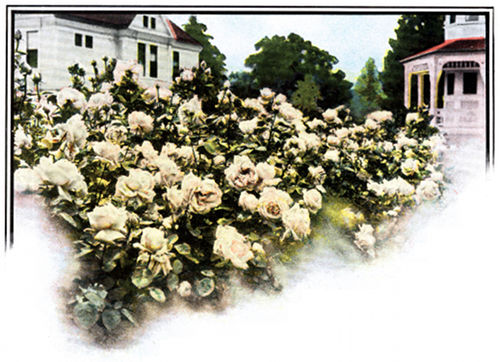
IN PORTLAND ROSES ADORN THE HOMES OF ALL WHO DESIRE THEM
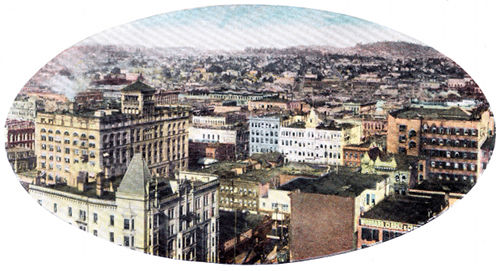
THE CITY OF PORTLAND SHOWS THE STIR OF PROGRESS AND COMMERCIAL DEVELOPMENT
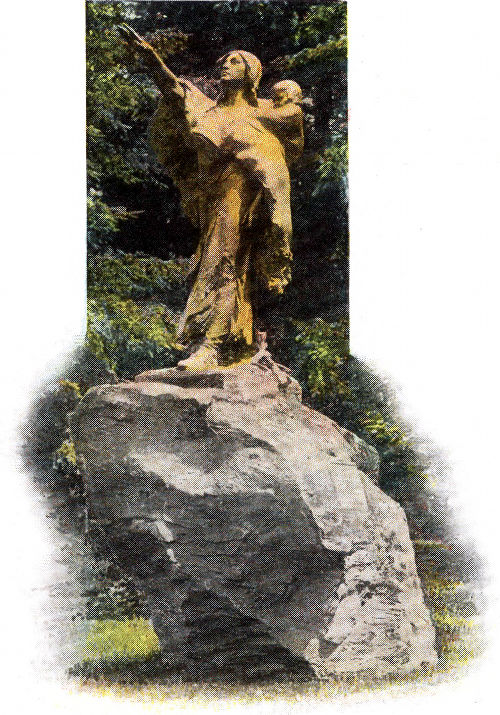
SACAJAWEA. THE BIRD WOMAN. THE FAITHFUL GUIDE OF LEWIS AND CLARK
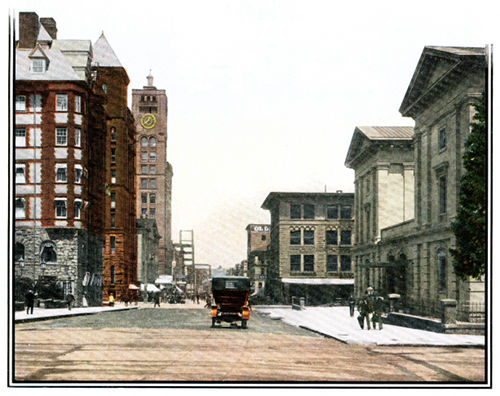
SIXTH STREET PORTLAND IS TYPICAL OF THIS PROGRESSIVE CITY. THE HOTEL PORTLAND AND “THE OREGONIAN” BUILDING ON THE LEFT
In Portland is the constant stir of progress and commercial development—it is in the air. With the completion of a forty-foot ship channel from the city to the sea, to which end surveys are being conducted by the government, the largest vessels will have no difficulty in making Portland. Business enterprises of all sorts thrive; the building up of attractive suburbs, and of seaside resorts such as Long Beach and Yaquina bay—all these mean that here is a city of 160,000 people that will bear watching. There is no use hurrying through Portland; there is too much to be seen and done; you cannot overlook the fast-flowing Columbia, with its close-bordered forests and its matchless cascades and varied scenery. Powerful and comfortable steamers stem the torrent of the mighty river and at the rapids of the Dalles, close to the mystical, mythical Bridge of the Gods, a system of locks has challenged and overcome Nature’s mastery of her aquatic highway. Portland is famous for its hotels and hospitality, its fine streets and buildings, its clubs, its schools and churches. Civic pride is evident everywhere; art galleries, a notable library, beautiful avenues, parks and homes, with an excellent car system reaching far out into its pleasant suburbs, all speak of culture, wealth and progress. Here the traveler may rest and think over his trip and consider his return journey, providing this western land so seemingly new, so ever green, so bustling with activity, so wide-awake, so climatically glorious, does not hold him, as it has held many others, in bonds that they would not break:
We have seen a world! We have chased the sun
From sea to sea; but the task is done.
We are hushed with wonder, we stand apart,
We stand in silence; the heaving heart
Fills full of heaven, and then the knees
Go down in worship on the golden sands
With faces seaward, and with folded hands
We gaze on the boundless white Balboa seas.
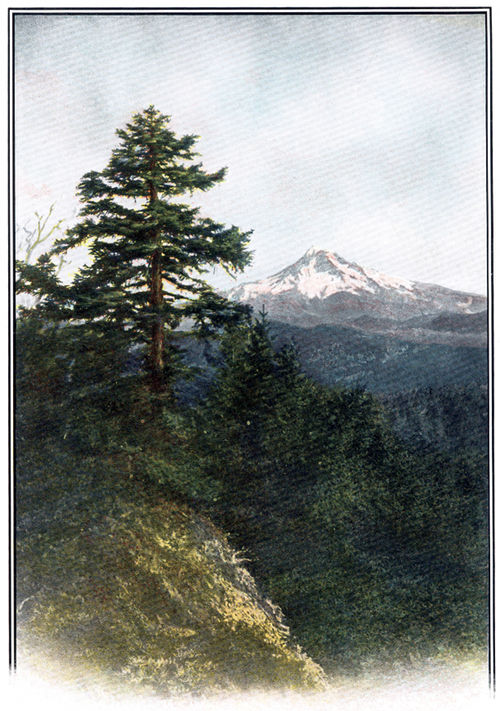
DAWN ON MOUNT HOOD
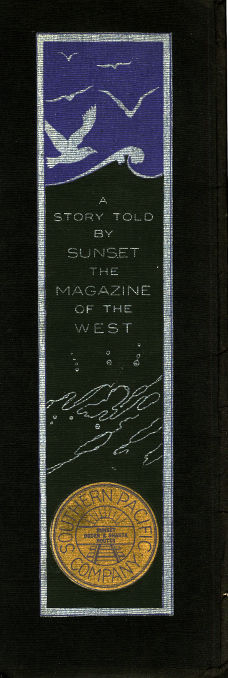
SUNSET, THE MAGAZINE OF THE WEST. PUBLISHED MONTHLY AT SAN FRANCISCO, CALIFORNIA—ONE DOLLAR AND FIFTY CENTS YEARLY—FOR SALE BY NEWSDEALERS EVERYWHERE
ENGRAVED AND PRINTED BY
H. C. TIBBITTS
SAN FRANCISCO, CALIFORNIA